MetaReview - Octopath Traveler II
Comparing and analyzing several game reviews of Octopath Traveler II
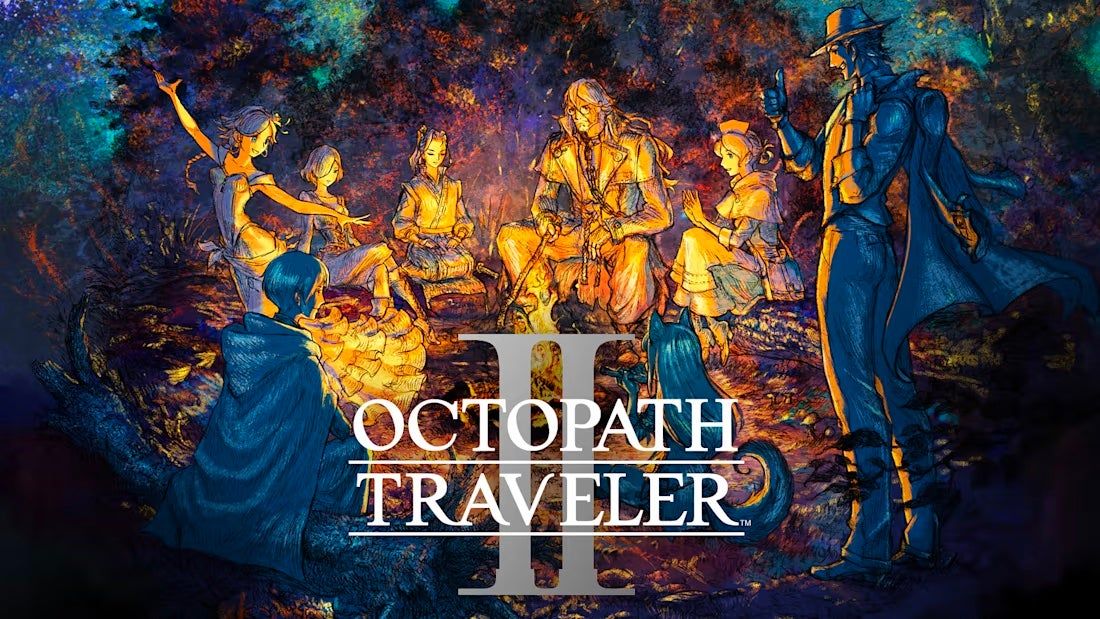
If a game review is an analysis of the execution of a game design proposal from a possible perspective, we can have a broader view if we compare several game reviews. We believe that this approach contributes to the history of video game reception and also to players and game designers having a more perspectivist view of the science and art of video games. So, if you’re looking for a synthesis of different critical views on a certain game, you’re in the right place.
Our premise is the same motivation that led to the creation of popular aggregators like MetaCritic and OpenCritic. However, we recognize that such sites are restricted to quantitative comparisons. We hold the belief that words hold greater weight than mere numbers. Therefore, our platform, MetaReview, offers a unique approach to video game reviews that combines qualitative assessments from different angles to provide a more comprehensive understanding of how a game was received and interpreted upon its release.
This proposal is complementary to that of my Comparative Criticism series. While Comparative Criticism is an analysis of a work in comparison with another, a Meta Review is a comparison between reviews or a "review of reviews", a synthesis and analysis of the critical reception of a video game.
Our method is simple and ensures diversity and proportionality. Based on Open Critic, we selected up to 10 reviews in the following divisions of this site: Mighty, Strong, Fair, Weak, and non-numeric review. Depending on the number of reviews in each of these divisions, we can have one to three selected reviews. The second rule is that at least 25% of selected reviews need to be non-English in order to be globally inclusive. The third and final rule is that at least 25% of the reviews need to include non-top critics (top critic = ☆), in order to bring in critics from smaller independent sites.
Today we will metareview Octopath Traveler II, a sequel to Octopath Traveler (2018), but takes place many years later in the same world and with new protagonists. The game has the same director (Keisuke Miyauchi) and the same producers (Tomoya Asano and Masashi Takahashi), developed by Square Enix and Acquire. We selected the reviews listed below:
- Heidi Hawes (WayTooManyGames) — 10/10 — English
- Kai (Use a Potion) — 9.5/10 — English
- Sebastian Quiroz (☆Atomix) — 92/100 — Spanish
- Gianluca Arena (☆Spaziogames) — 8.8/10 — Italian
- Vítor M. Costa (Nintendo Blast) — 8.5/10 — Portuguese
- Ollie Barder (☆Forbes) — 8.0/10 — English
- Killy_Log1 (☆Gameblog) — 7/10 — French
- Jon Bailes (☆GamesRadar+) — 3/5 — English
- Katharine Castle (☆Rock, Paper, Shotgun) — Unscored — English
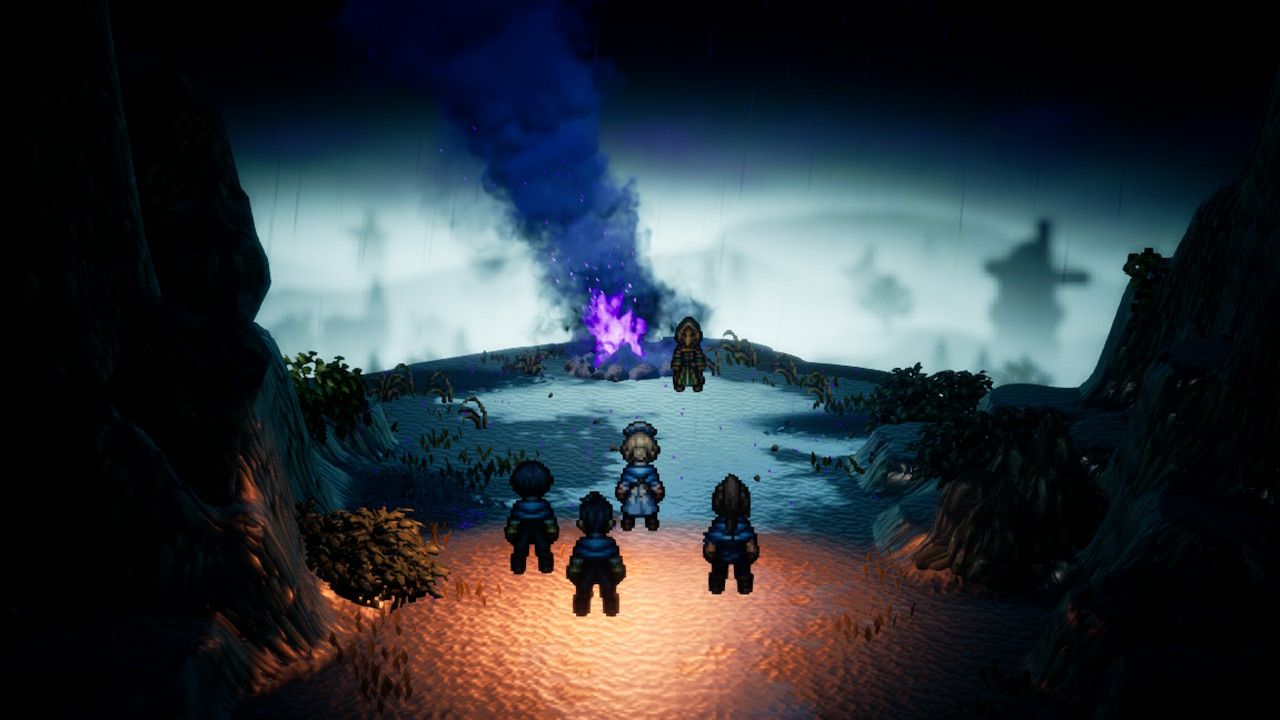
Narrative Criticism Counterpoints
Written by Takashi Hino and Kakunoshin Futsuzawa (the same person who worked on the first Octopath Traveler and Octopath Traveler: Champions of the Continent), the plot of Octopath Traveler 2 follows the formula of the first game in the series of segmenting its narrative into eight independent subplots (one for each protagonist), which have three to five chapters each.
The themes of each plot are quite different: some stories are more epic and classic, like Hikari and Ochette; others are casual, like de Agnea and Partitio; some are tragic, like Throne and Osvald; and others are of mystery, like Temenos and Castti. This variety can also help break the monotony and experience the world of Solistia from different perspectives, such as through the perspective of an exiled prince (Hikai), a priest (Temenos) intrigued by some secrets of the Church, a thief an orphan (Throné) raised and imprisoned since childhood by a group of bandits, or simply a simple dancer (Agnea) with dreams of being a big star.
Finally, there is a brief final route that integrates the journey of the characters and their subplots that, until then, seemed almost entirely independent. During most of the game, the most relevant connections between the characters are in the Crossed Paths Routes, four shorter parallel routes, each involving the collaboration of two protagonists:
- Agnea Bristarni (dancer) and Hikari ku (warrior);
- Osvald V. Vanstein (scholar) and Partitio Yellowil (merchant);
- Temenos Mistral (cleric) and Throné Anguis (thief);
- Castti Florenz (apothecary) and Ochette (huntress).
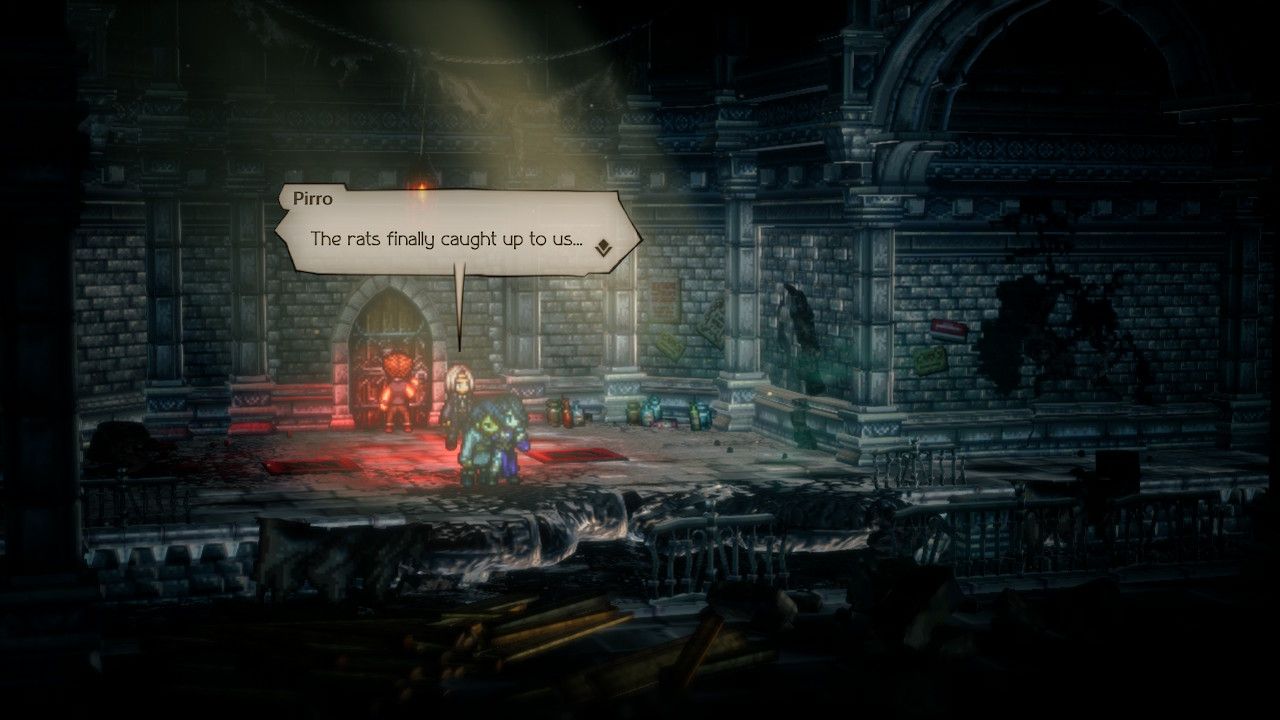
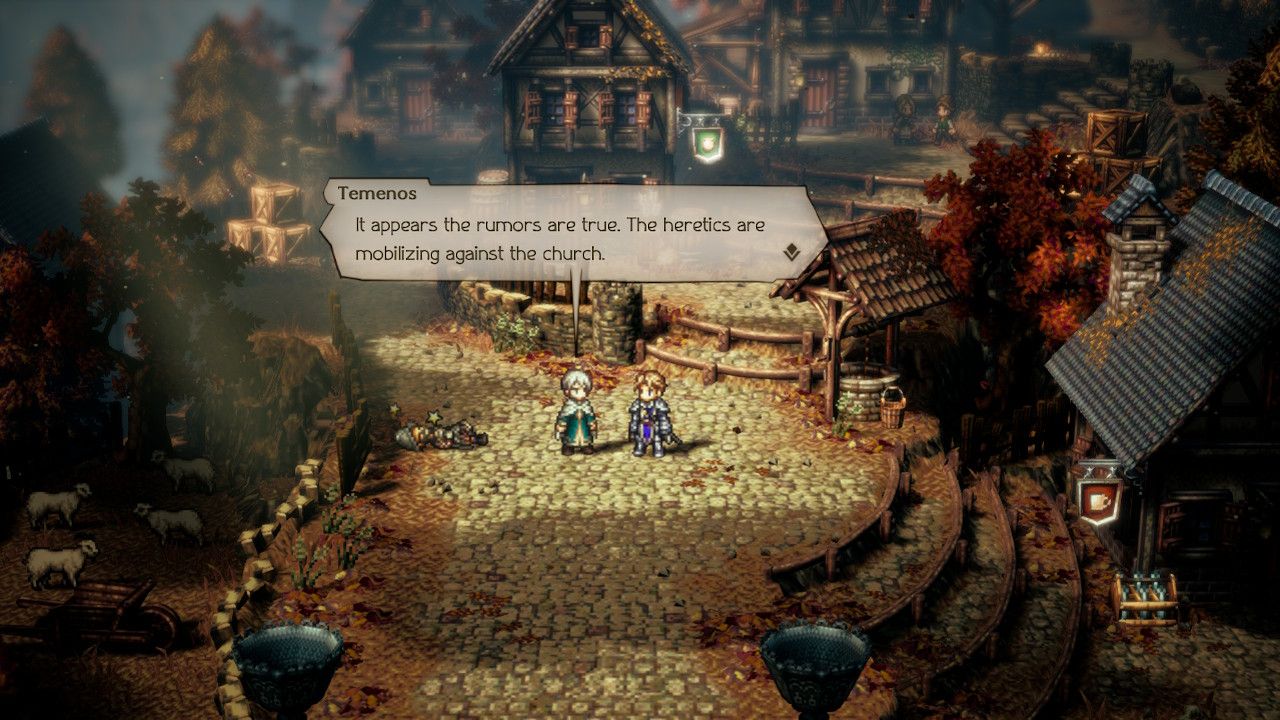
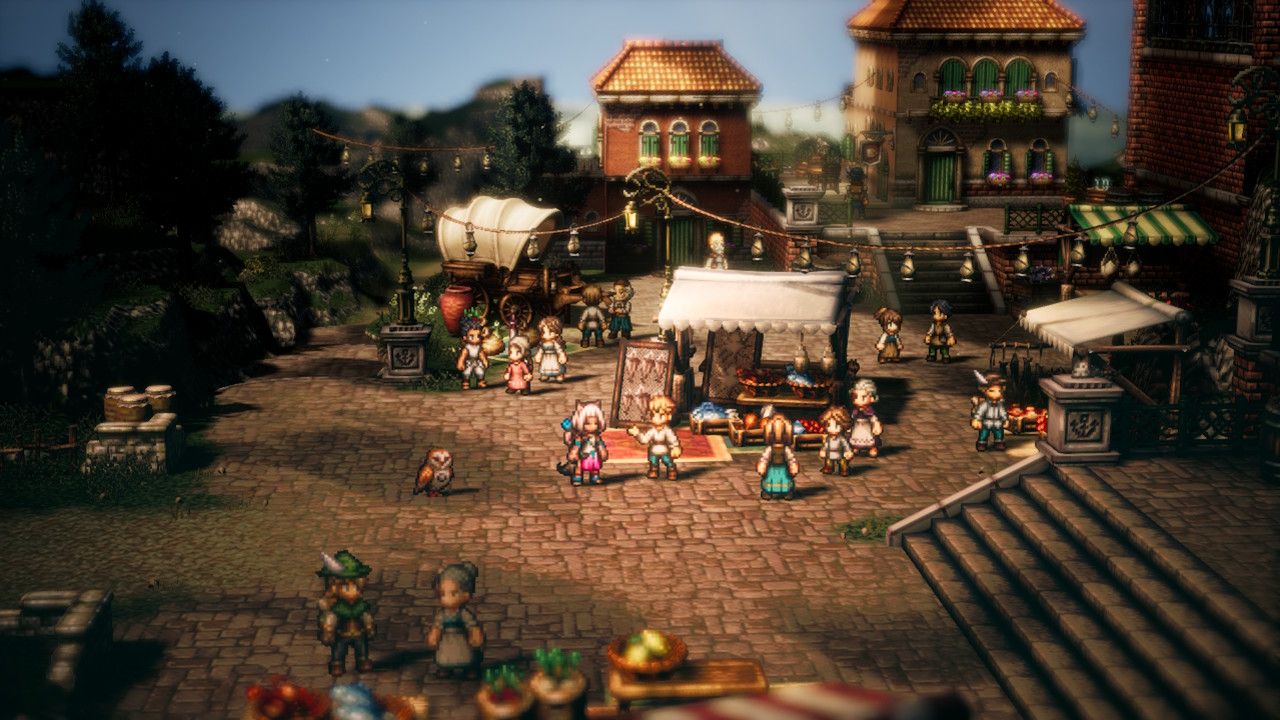
Octopath Traveler II. Source: Author.
The main point of criticism in this game was its narrative design. While the characters, particularly Crossed Path, received praise, the efforts of Team Asano were generally regarded as commendable but not enough to establish a strong connection between the different storylines. This was a recurring issue, one that had already been highlighted in its 2018 predecessor.
"The only thing working against the combined storytelling is the fact that other characters don’t always necessarily affect the individual plots. Sure, the Crossed Path events see characters working together and there’s plenty of banter between them on your journey, but rarely did they feel like they directly affected one another. Whilst the isolated form of storytelling does make each narrative thread feel distinct to each character, it does feel like it works against the game’s overall theme of everyone coming together. It’s nit-picking, but it’s one of the gripes that I had from the original game that hasn’t seen much improvement here."
— Kai (Use a Potion)
"And if each of the destinies is much better told than in the previous opus, through more endearing protagonists, the game struggles to tell its overall story. Especially since the progression does not help to immerse yourself in the story, either."
— Killy_Log1 (☆Gameblog)
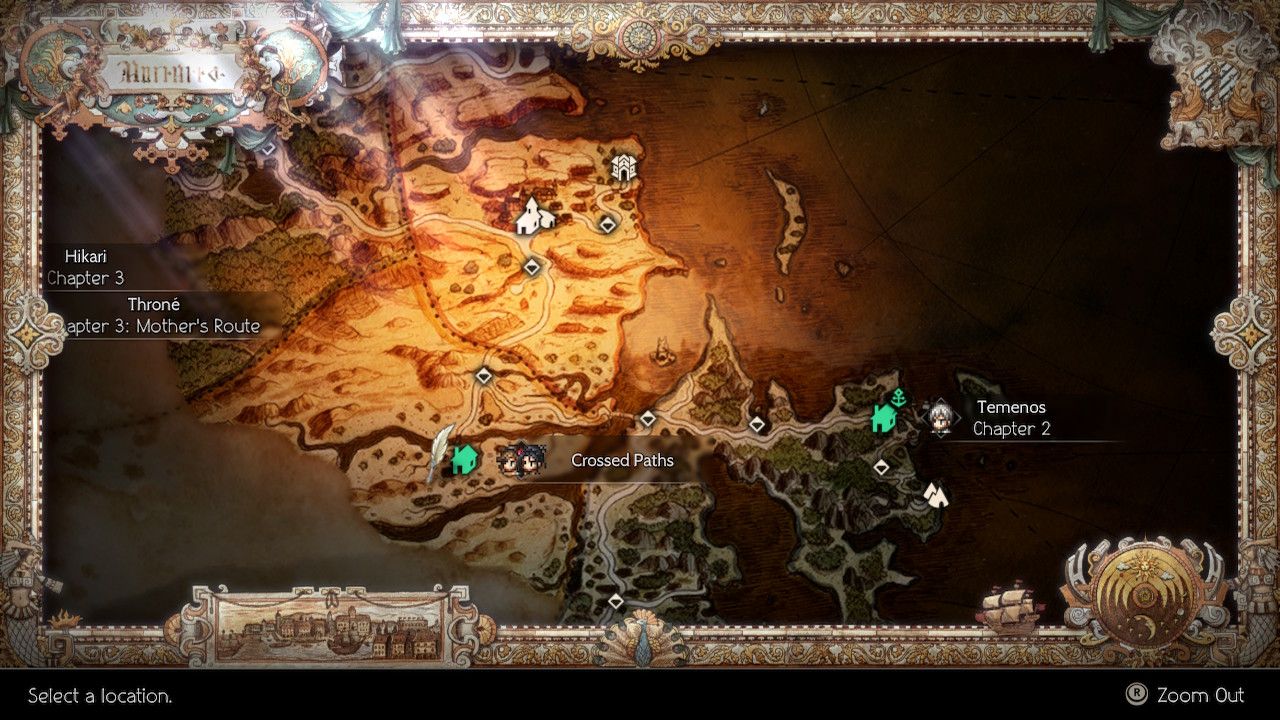
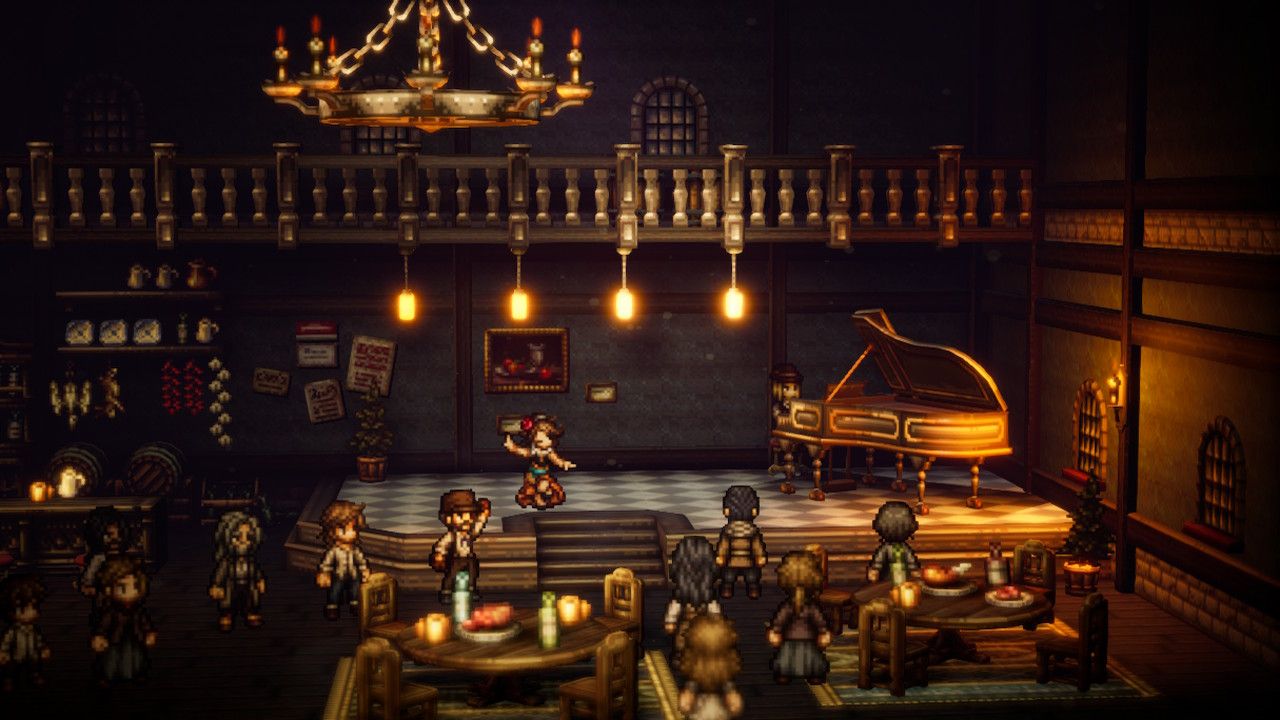
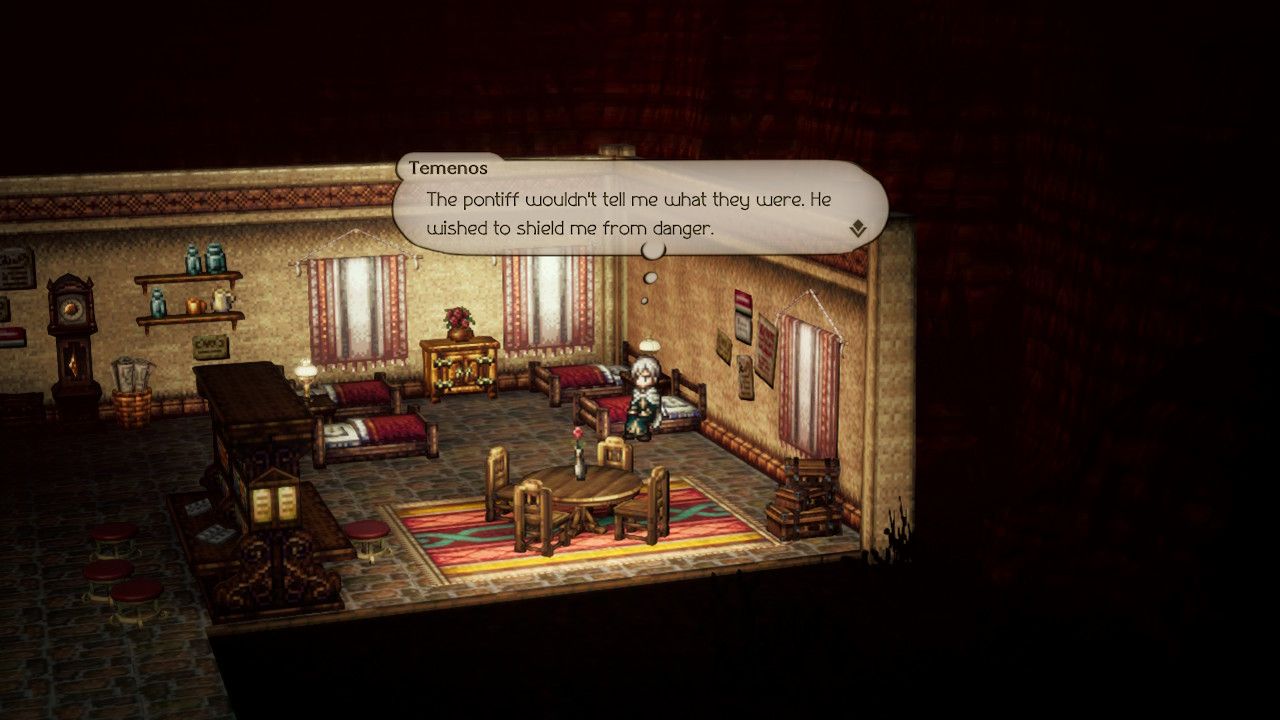
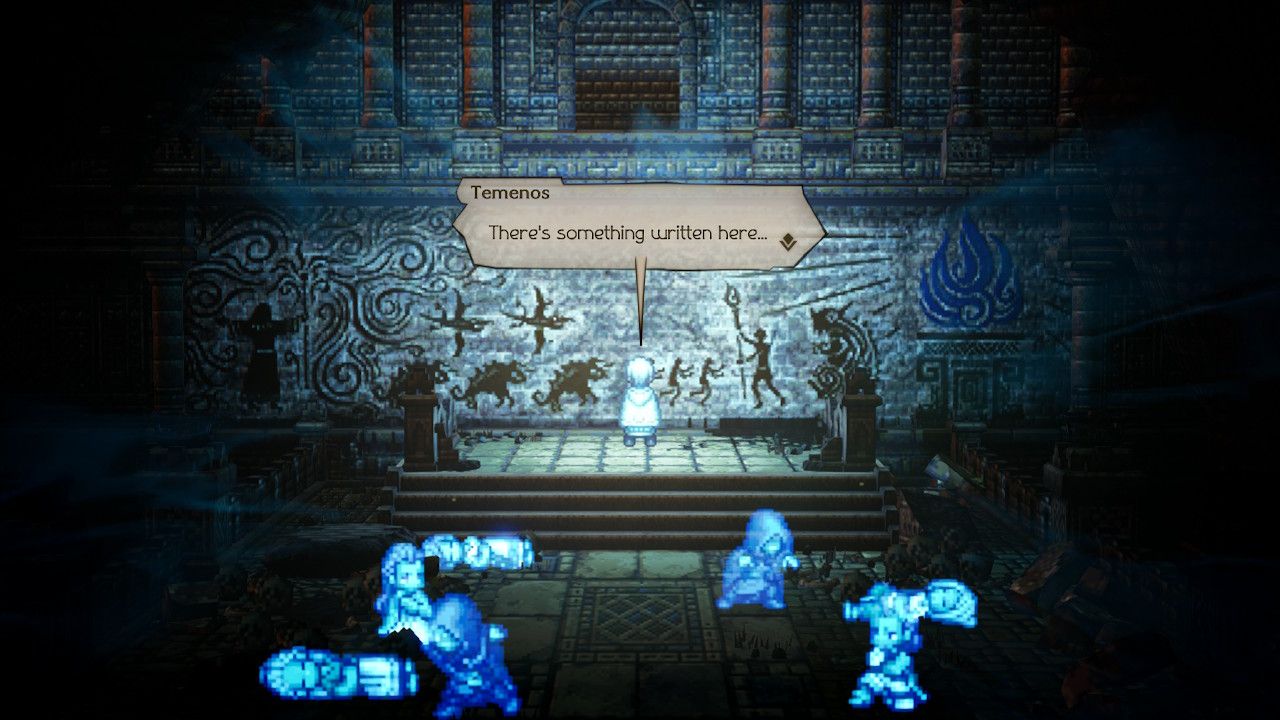
Octopath Traveler II. Source: Author.
Critics highlighted several negative aspects of the game. Among these was the lack of well-developed secondary characters in most of the storylines. While exceptions existed, such as the interaction between Temenos and Crick, the majority fell short in this regard. Additionally, the quality of writing in the eight stories was deemed inconsistent. While some, like Osvald, Hikari, and Throné, received praise, others were criticized for their reliance on clichés, simplicity, and artificiality. Nonetheless, some critics saw the "glass half full" in the game's offering of a variety of narrative tropes.
"Fortunately, Octopath Traveler II makes more hits than misses in its narrative. Each of the eight stories is extremely interesting, even those that may seem boring at first. While they don't break the mold, they are able to use all the tropes to their advantage to create a series of entertaining adventures that make it clear that the classics will never die. Let's take Throné and Temenos as examples. These two characters walk a path of revenge and mystery, respectively, that we've seen countless times in the past, and all of the little twists they present can be seen from a distance.
[...] Even at the other end of the spectrum we find Agnea, a dancer who grew up with stories from her mother, and has the support of her father to fulfill her dreams, so her idea of solving her problems with a dance and a song makes sense. Even Partitio, who shouldn't function like a capitalist looking for a socialist solution to his problems, makes sense when we see him growing up in a town facing change similar to that of the industrial revolution."
— Sebastian Quiroz (☆Atomix)
"In this way, the travellers' tales are not only bland by modern standards but lionise archetypes such as kind and just hereditary leaders, morally upstanding inquisitors and good capitalists. Added to the fact that Octopath Traveler 2 is a little too content to rest on its laurels, and it shows that while nostalgia can be a joyous experience, becoming too enraptured by the past can easily default to conservatism."
— Jon Bailes (☆GamesRadar+)
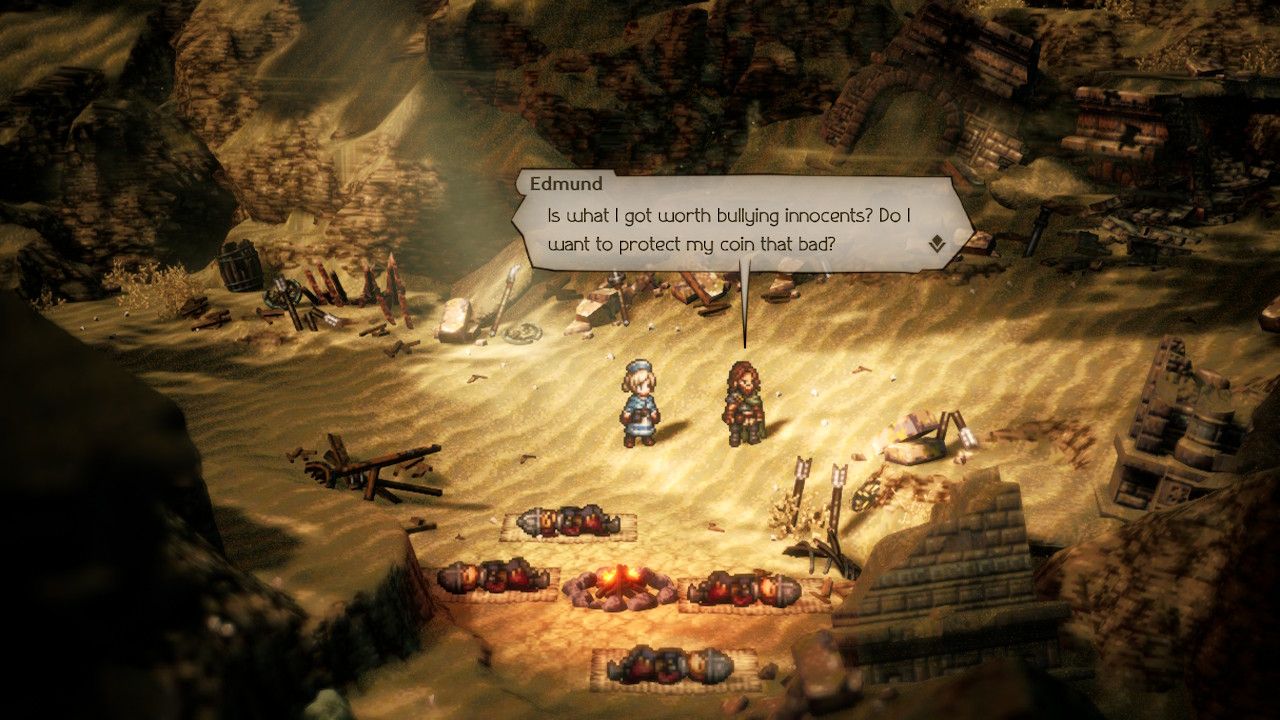
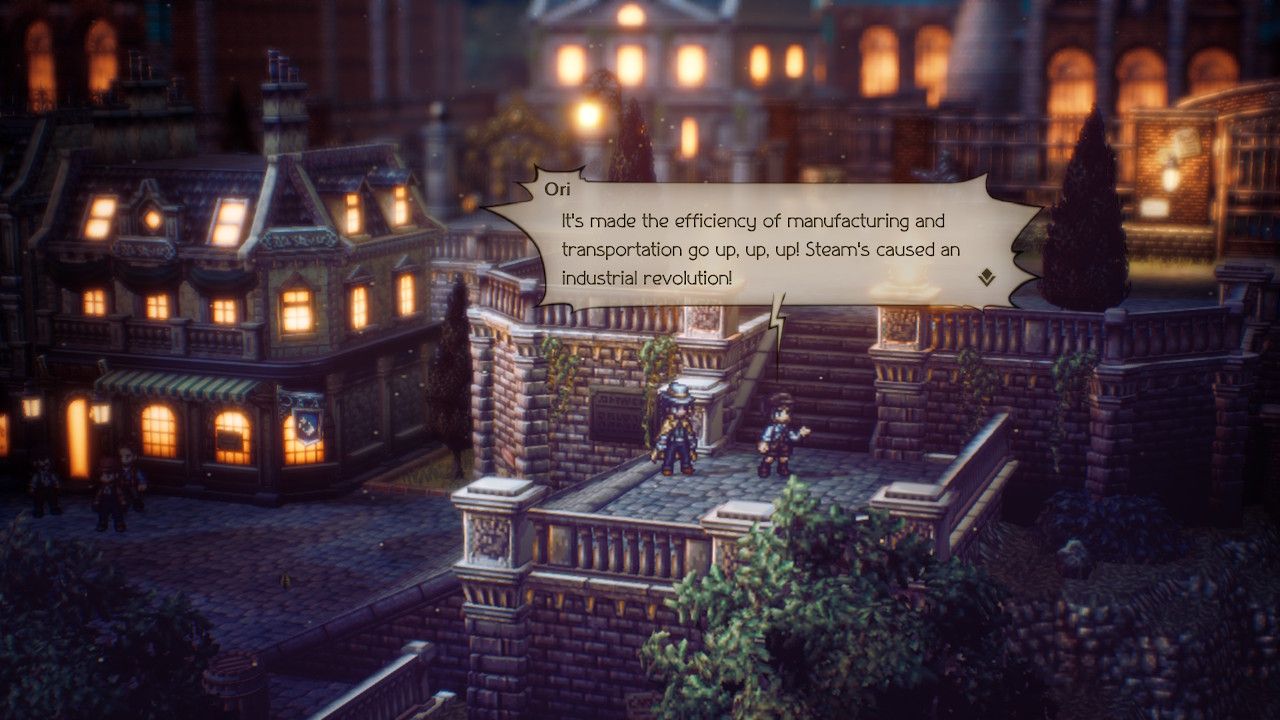
Octopath Traveler II. Source: Author.
Gameplay Experiences
In terms of turn-based RPG gameplay, Octopath Traveler II continues with the same systems as its predecessor, such as the Boost system, which allows characters in the party to accumulate Boost Points (BP). These points are used to amplify the power of abilities or allow a character to attack more times with a common attack. Once again, we have the possibility to hit enemies in their weaknesses (Break) to make them temporarily stunned.
In addition, we have the Job System again, with classes such as merchant, hunter, warrior, and others. Each character has a fixed job, but can also combine their class with a secondary class, which can be switched freely. Each character evolves their skills for each class separately with Job Point (JP) but can preserve and select passive skills after switching classes.
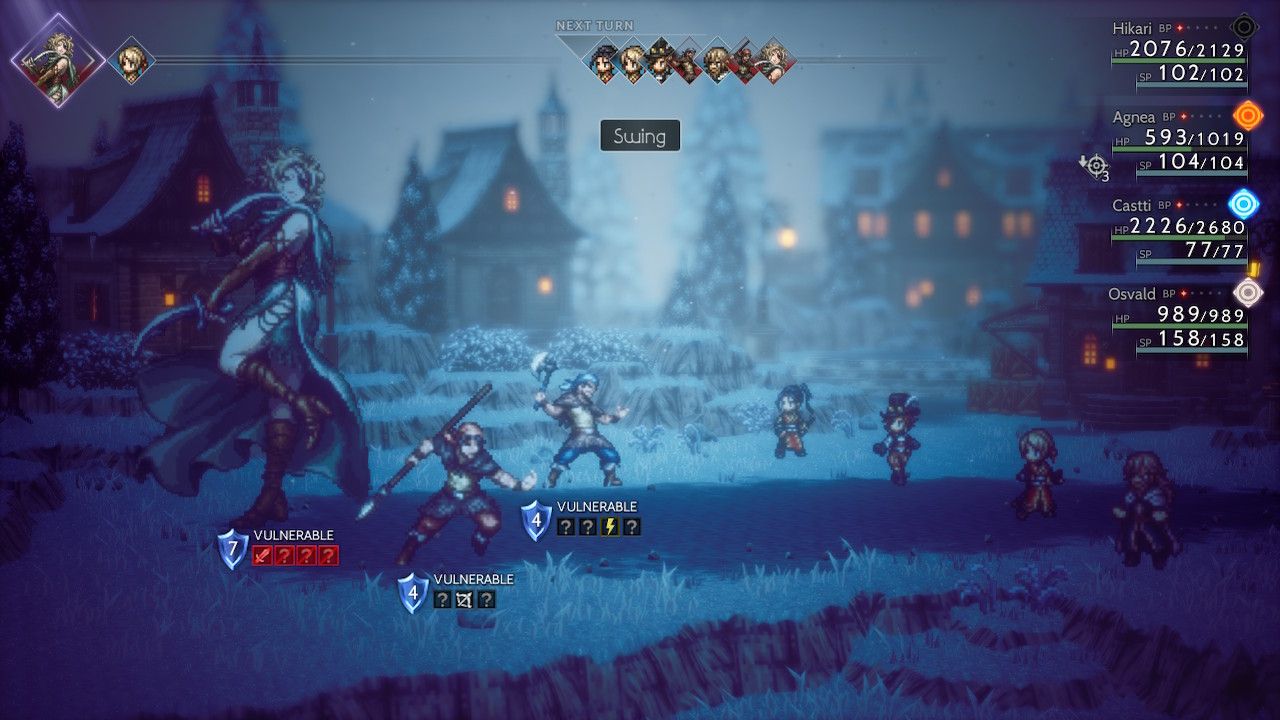
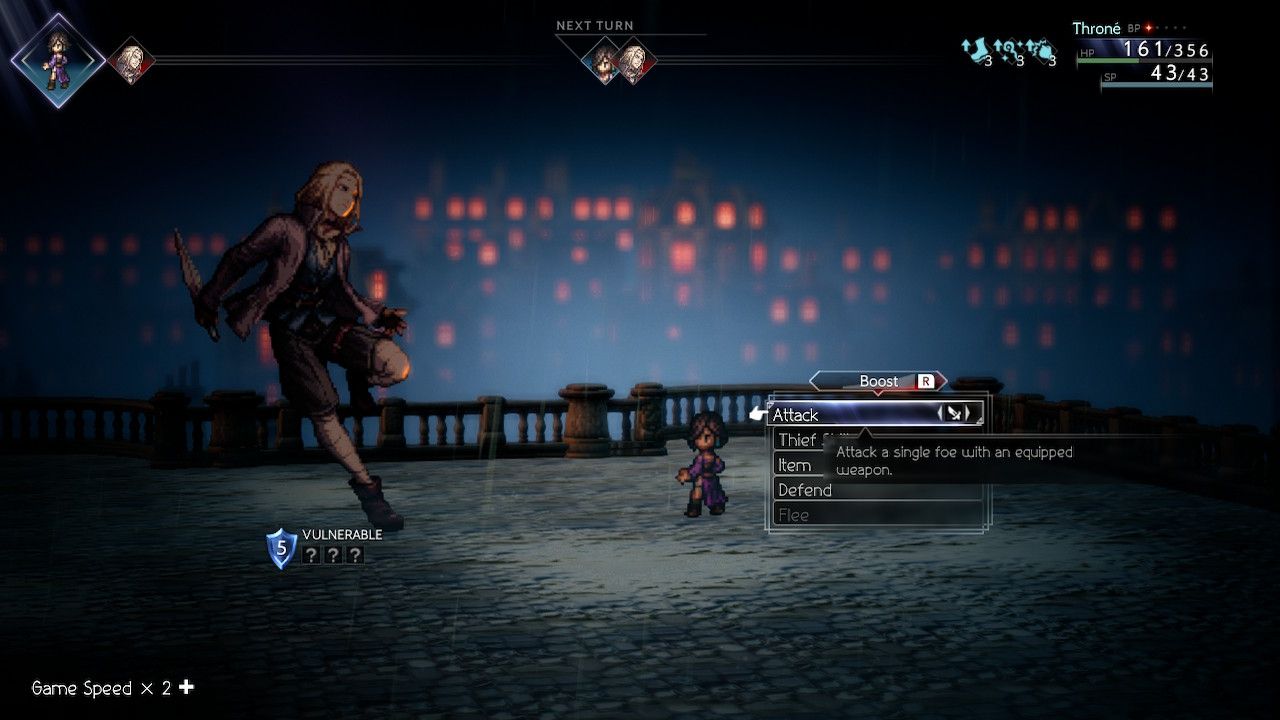
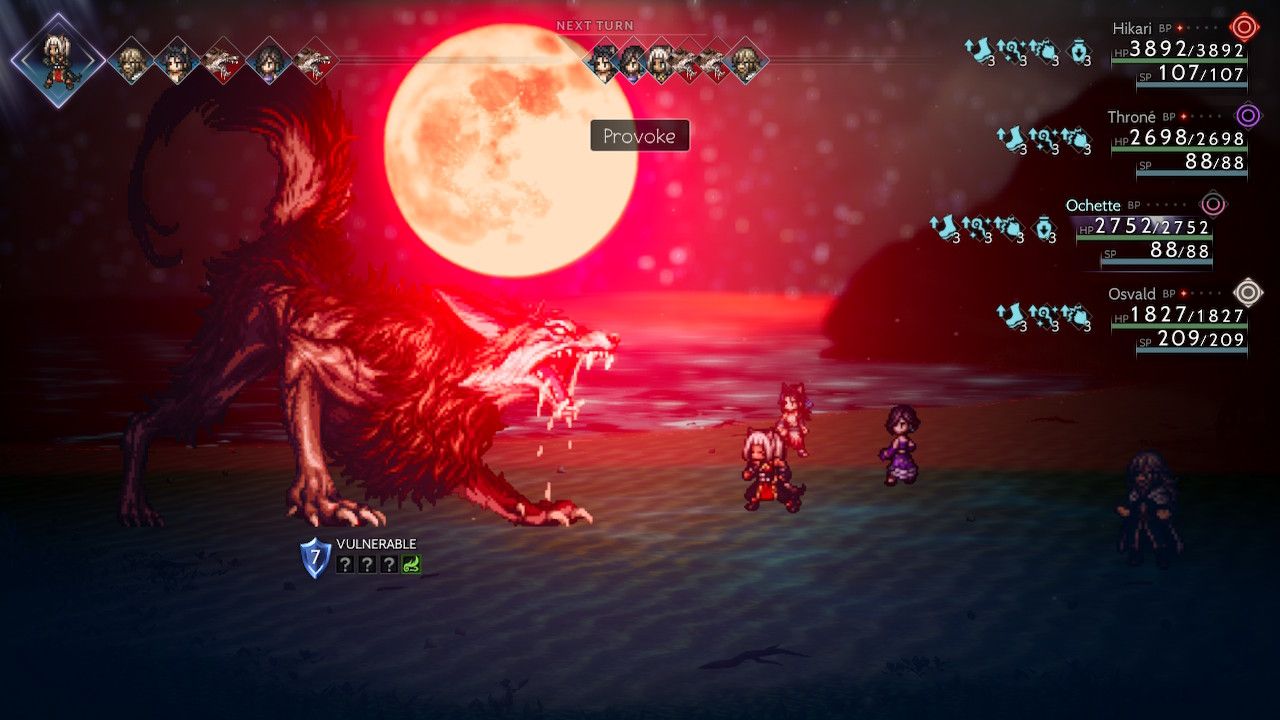
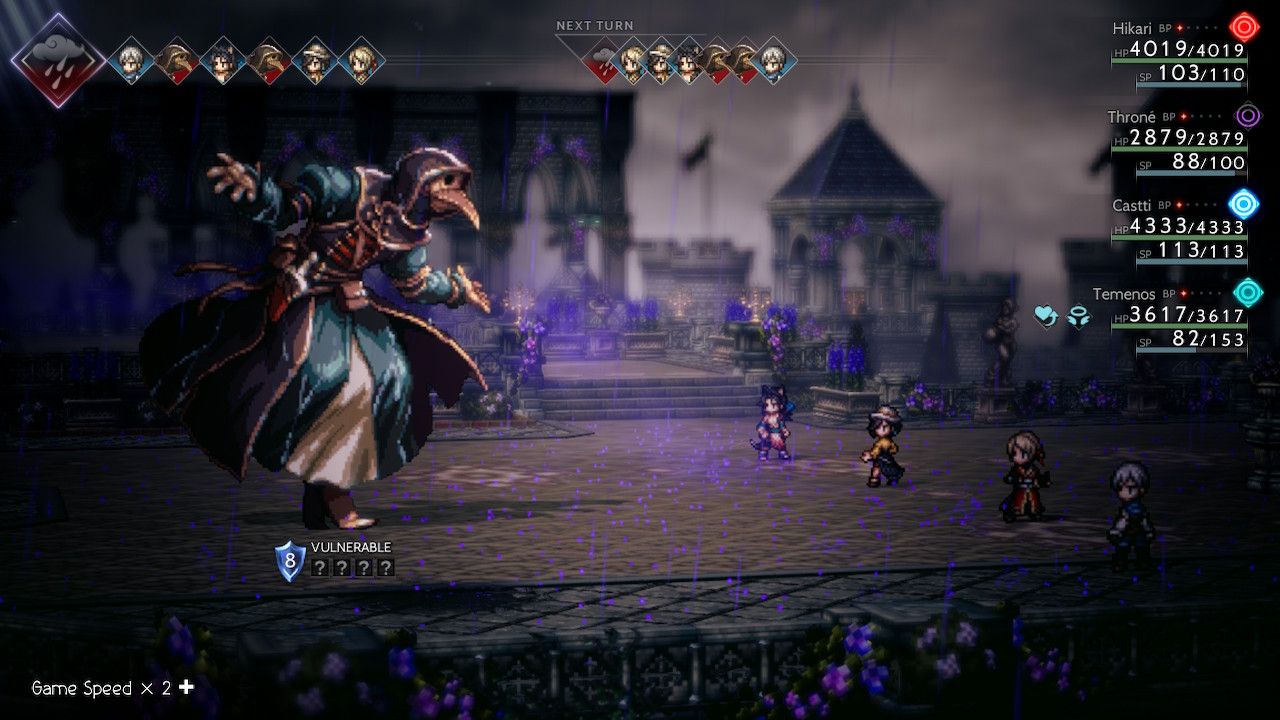
Octopath Traveler II. Source: Author.
The standout new feature in combat is Latent Power, which functions similarly to the iconic "Limit Break" from Final Fantasy VII. It allows the player to unleash a unique ability after taking and dealing a certain amount of damage. Furthermore, each character now has access to distinct powers to use against non-player characters, such as stealing, investigating, or dueling. One skill can be used during the day, and the other at night. This particular gameplay element garnered significant praise in Octopath Traveler II.
"It’s a really neat concept that I was already a fan of in the first game, but it has been expanded upon here with the introduction of a day-and-night system that alters the Path Action you have available. You might also encounter different characters or face different scenarios depending on the time of day, so the change in time always feels significant. You’ll even face more challenging enemies at night whilst some combat skills are only active at specific times of the day, so it affects more than just your exploration across the world. Fortunately, you can switch between night and day on the fly, so you’re never forced to wait for the sun to set to tackle different scenarios in the game. It’s a cool concept that complements the game’s unique approach to exploration."
— Kai (Use a Potion)
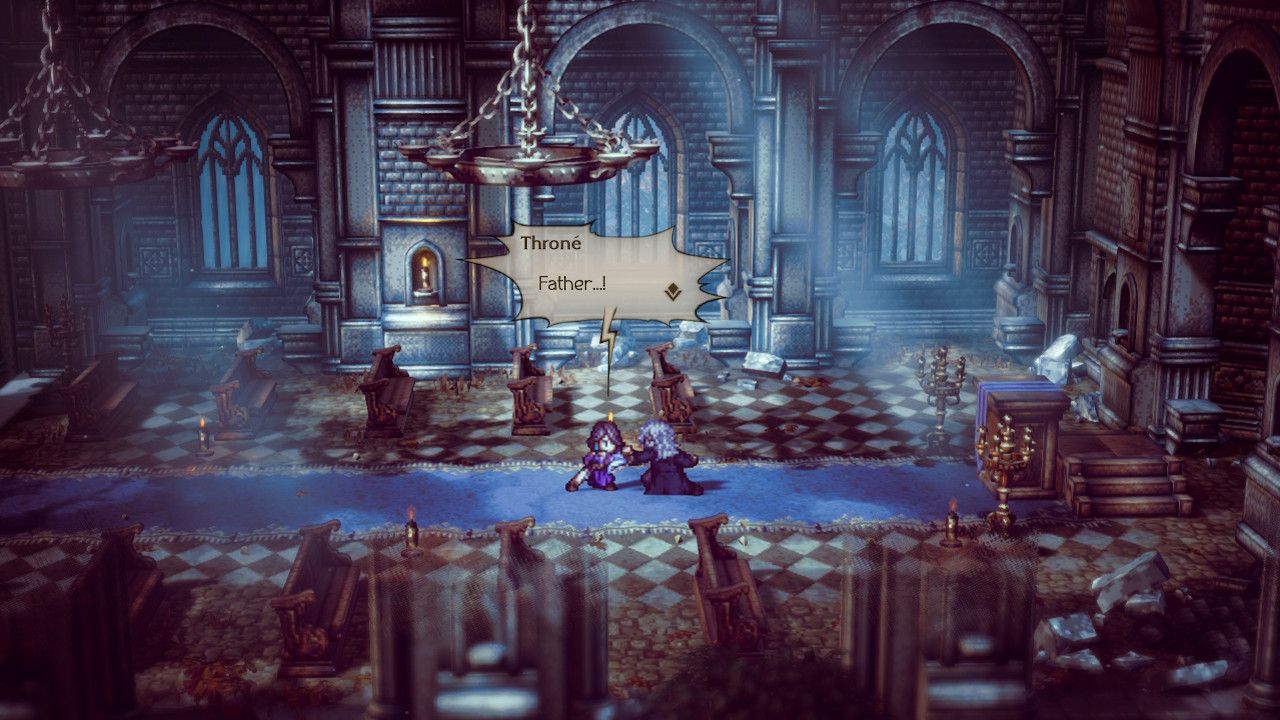
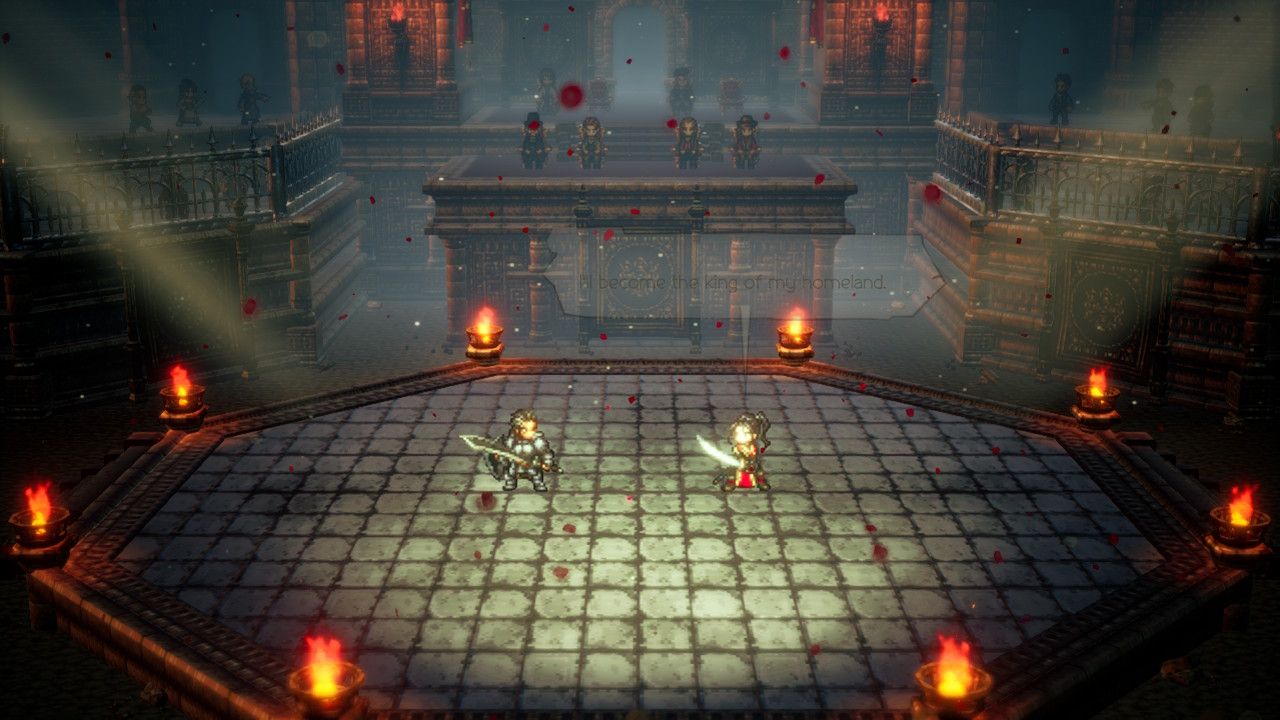
Octopath Traveler II. Source: Author.
Critics also praised the job system in Octopath Traveler II. It is more varied and flexible, and each character has unique characteristics, even when they have the same role as the party, such as support or attack.
"Thanks to the fact that we have eight people, it is possible to create a large number of combinations in our four-man team. All and each of the available heroes plays a role, and even when you believe that a pair works in a similar way, you realize that there are a series of differences that make them indispensable in certain cases. For example, Temenos and Castti are focused on healing, but the way they do it is different. The cleric is able to use magic to heal all characters in an instant, and can also summon shields. For her part, the healer uses potions that she herself creates to relieve the pain of a specific ally, with a focus on eliminating the poison or other ailments that someone has."
— Sebastian Quiroz (☆Atomix)
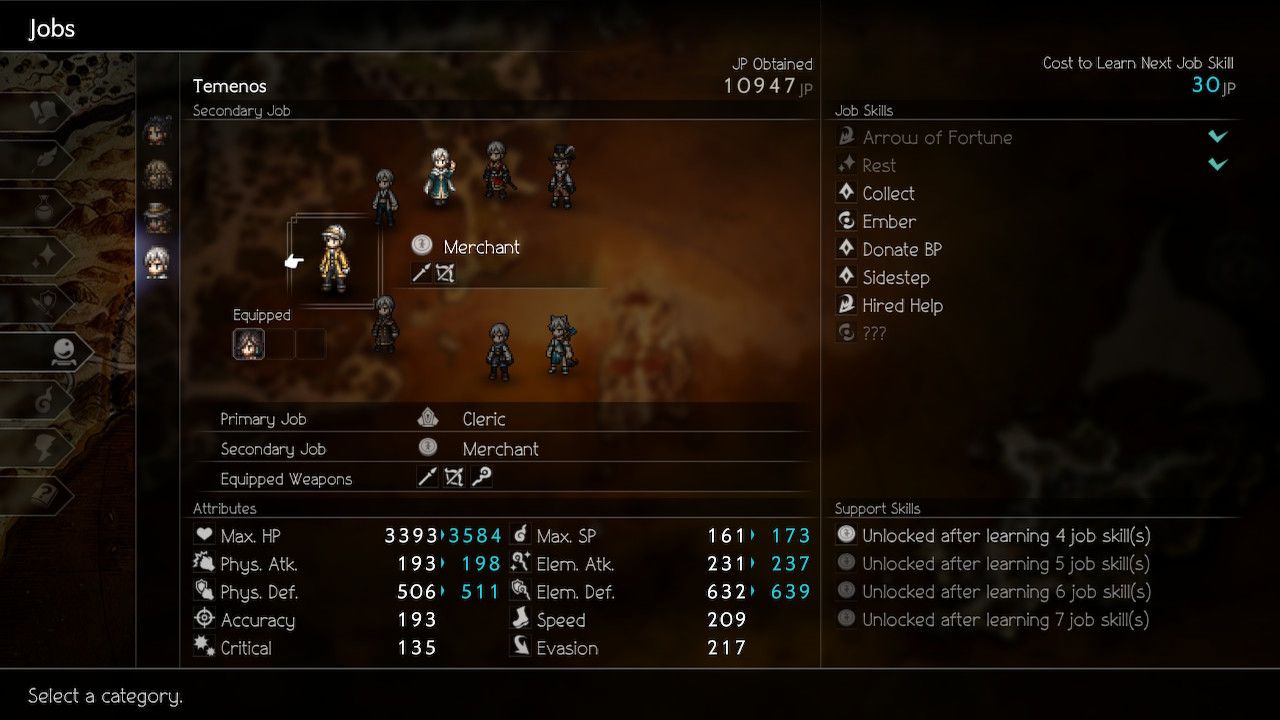
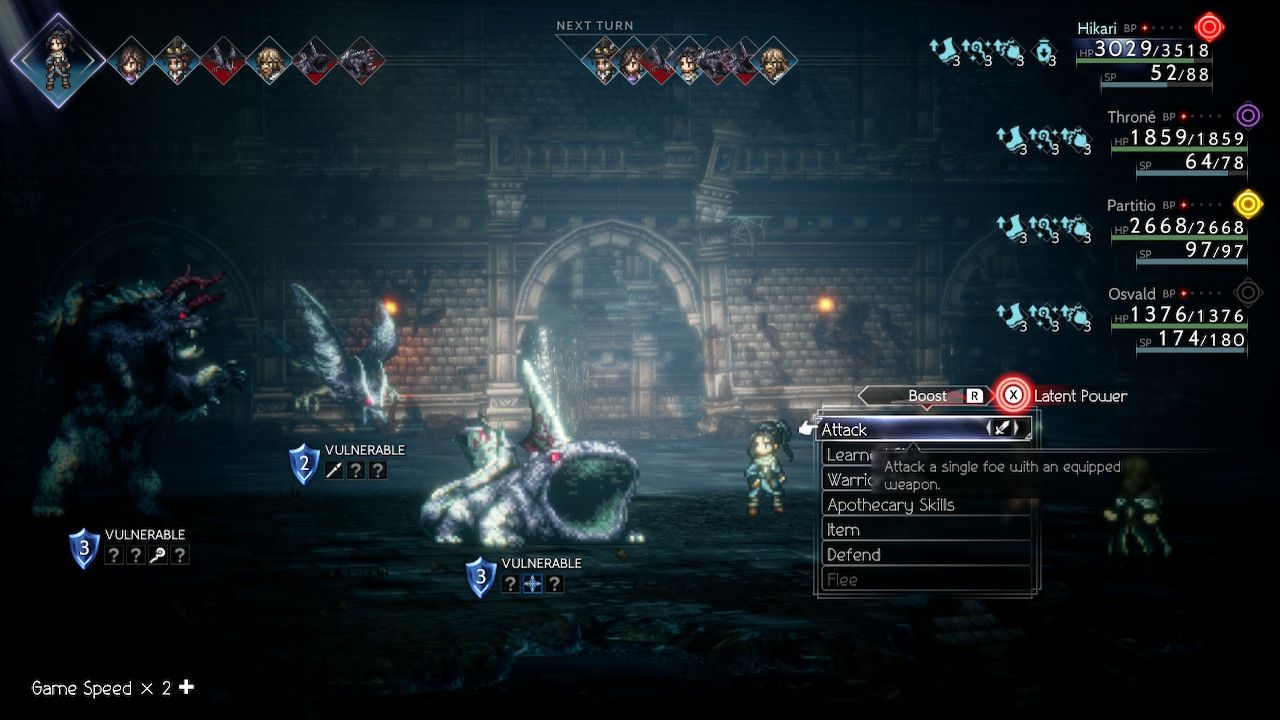
Octopath Traveler II. Source: Author.
On the other hand, the grinding problem persists. It's something that was criticized in the first Octopath Traveler. That seems to have improved in this sequel, but not enough. This is mainly caused by two factors.
One of them is the fact that the characters alternate in the party. It is only possible to use four at a time among the eight that are available in the game. In this context, one character can be much weaker than another. Additionally, there is a recommended level requirement for each chapter of each character’s story, which will encourage you to grind, particularly in the final chapters.
"Octopath Traveler 2 still hasn’t solved the problem of what happens to the four characters waiting in the wings while you’re off doing another storyline, either. You can swap them in whenever you get to a tavern, but the rest of the time they just sit there, not accumulating EXP or being at all useful. As such, I started to see exactly the same level gaps emerge as the game went on, where my strongest and best fighters were often ten levels ahead of my weaker backup squad. It is a fraction easier to grind them up this time round, the new night cycle offering stronger monsters than those around in the daytime, but grinding in itself still feels like a somewhat tiresome solution to an issue that many other JRPGs – many of them made by Square Enix themselves – managed to fix ages ago."
— Katharine Castle (☆Rock, Paper, Shotgun)
"Indeed, the inflexible level recommendations that gate areas and chapters are something of a stumbling block once again in Octopath Traveler 2. After collecting my gang, I found myself substantially over-levelled for most of the second round of chapters, rendering them a dull slog, then unable to keep all my characters up to speed later on without committing to lengthy bouts of grinding."
— Jon Bailes (☆GamesRadar+)
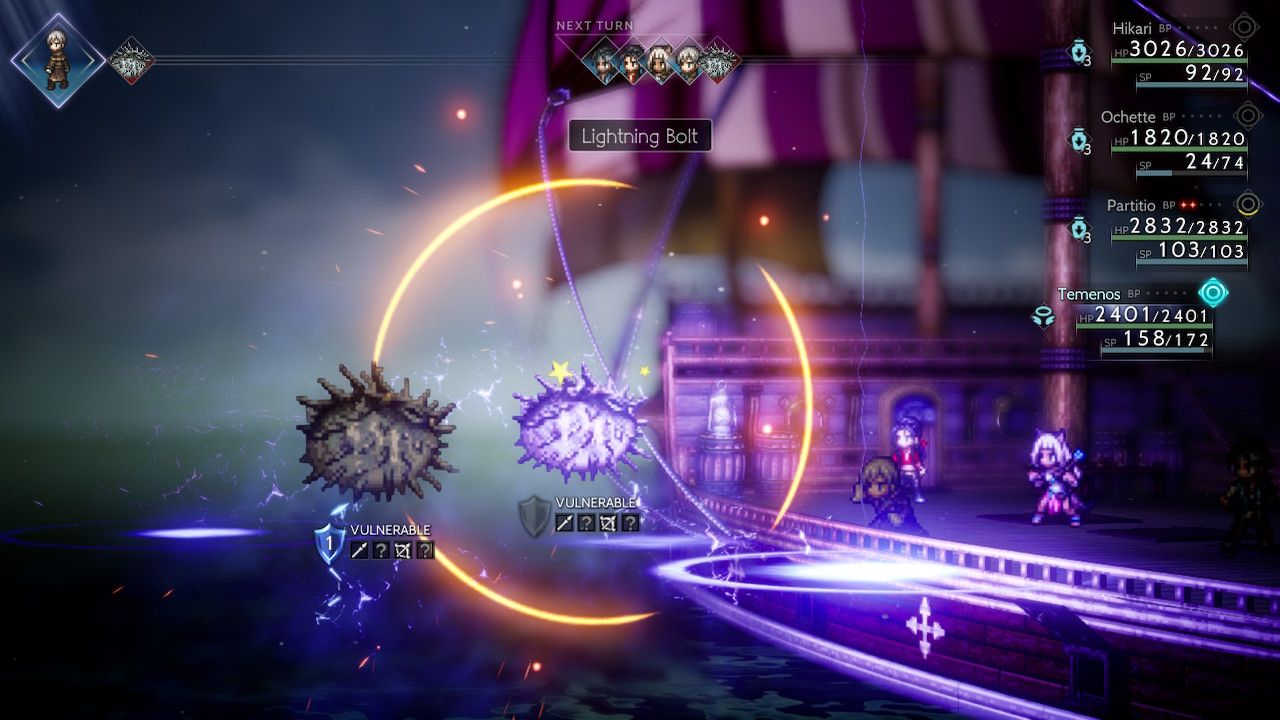
Finally, there is some criticism regarding the lack of gameplay innovation, both in combat and exploration. In the battle system, the experience is quite satisfying, but in exploration it’s simple.
"If the contextual actions of the protagonists have changed, they are still used in the same way; if the roles of each are new, they are based on mechanics similar to a good part of those of the first episode. In short, Octopath Traveler II is advancing at a very small pace."
— Killy_Log1 (☆Gameblog)
"In addition, the exploration in dungeons is practical, being able to use Game Speed 2x to speed up the walk, and the scenarios have a good extension; they are not exhausting or monotonous. It is also favorable the fact that it is easy to move around the map by teleportation through the cities already visited. On the other hand, exploration follows simple paths, with only a few hidden chests, and random encounters can still be annoying at times, but tolerable."
— Vítor M. Costa (Nintendo Blast)
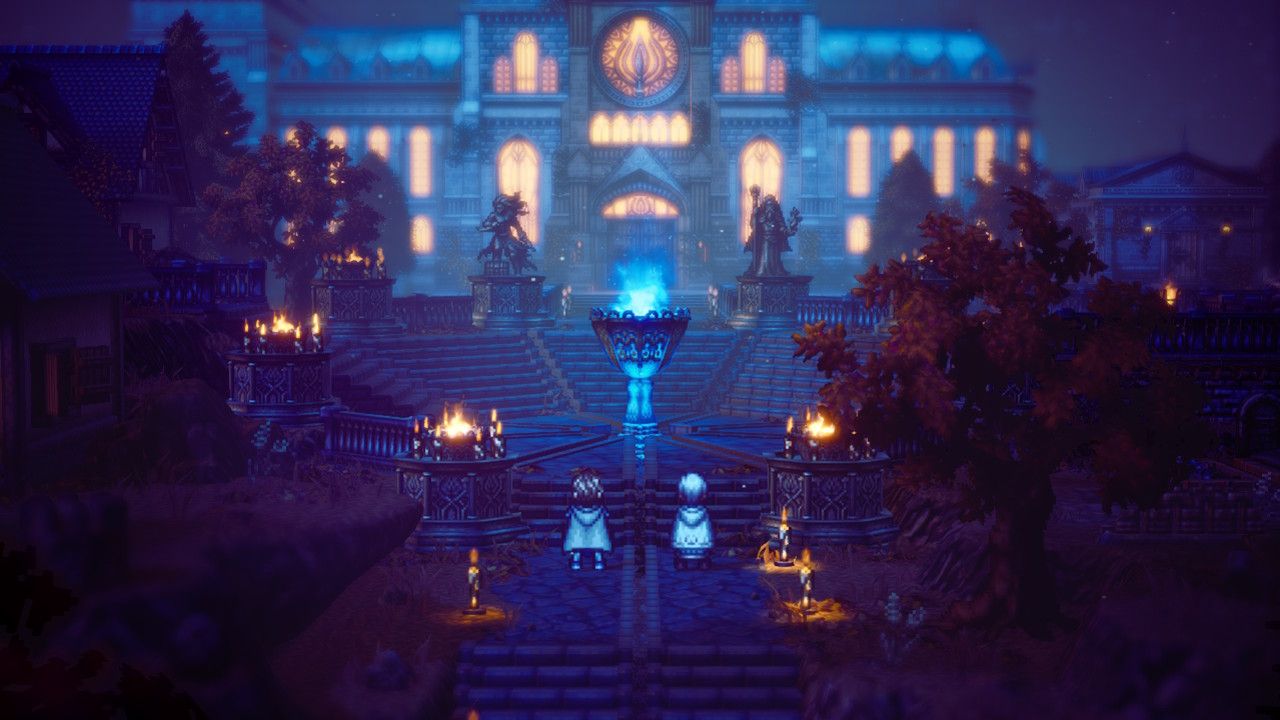
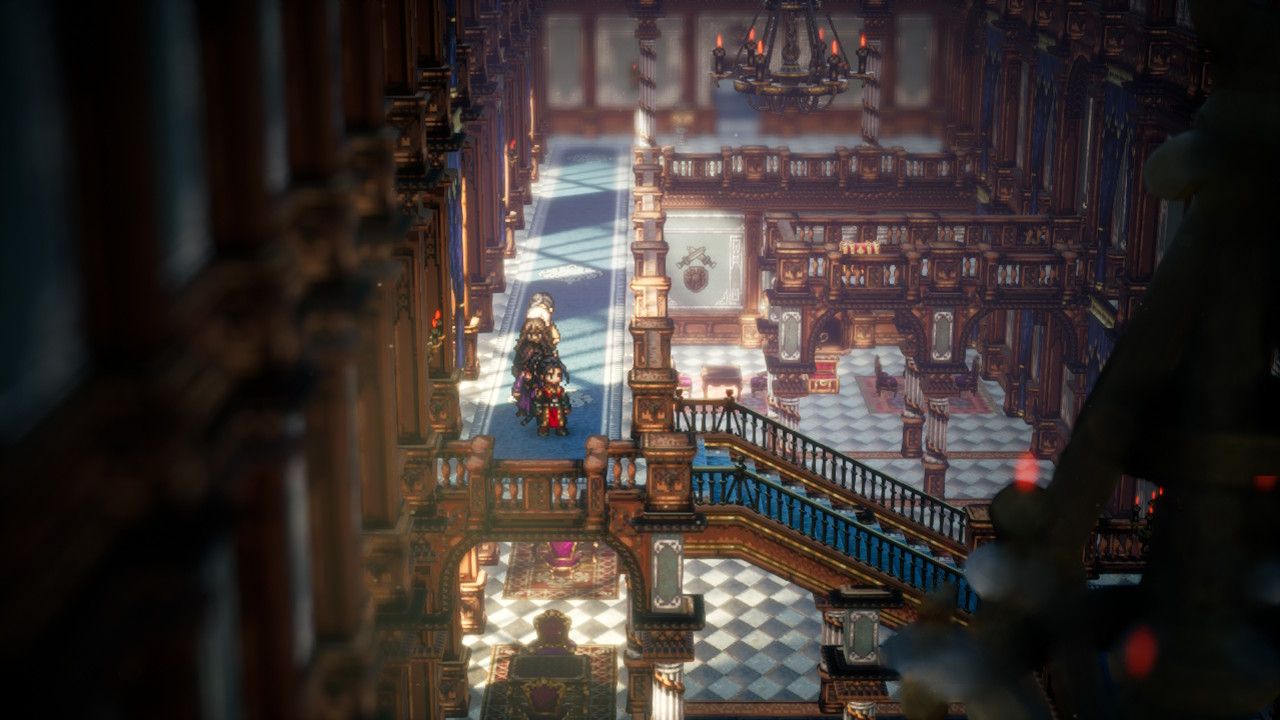
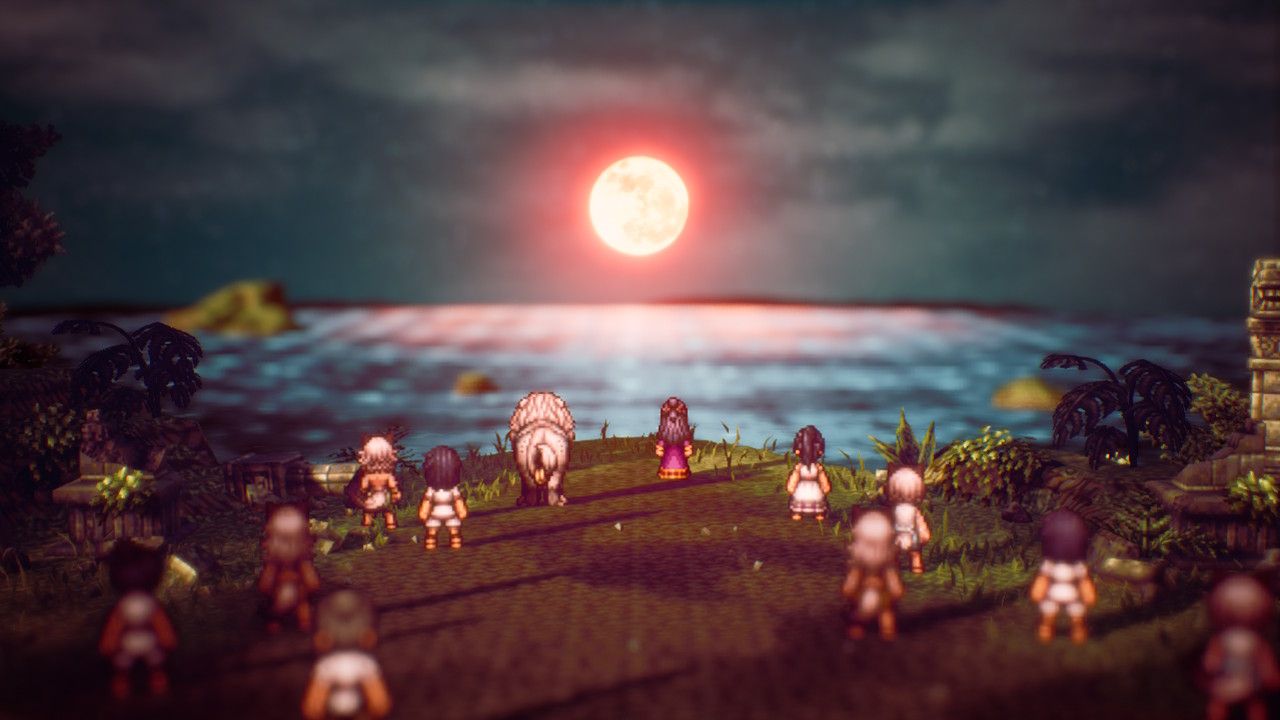
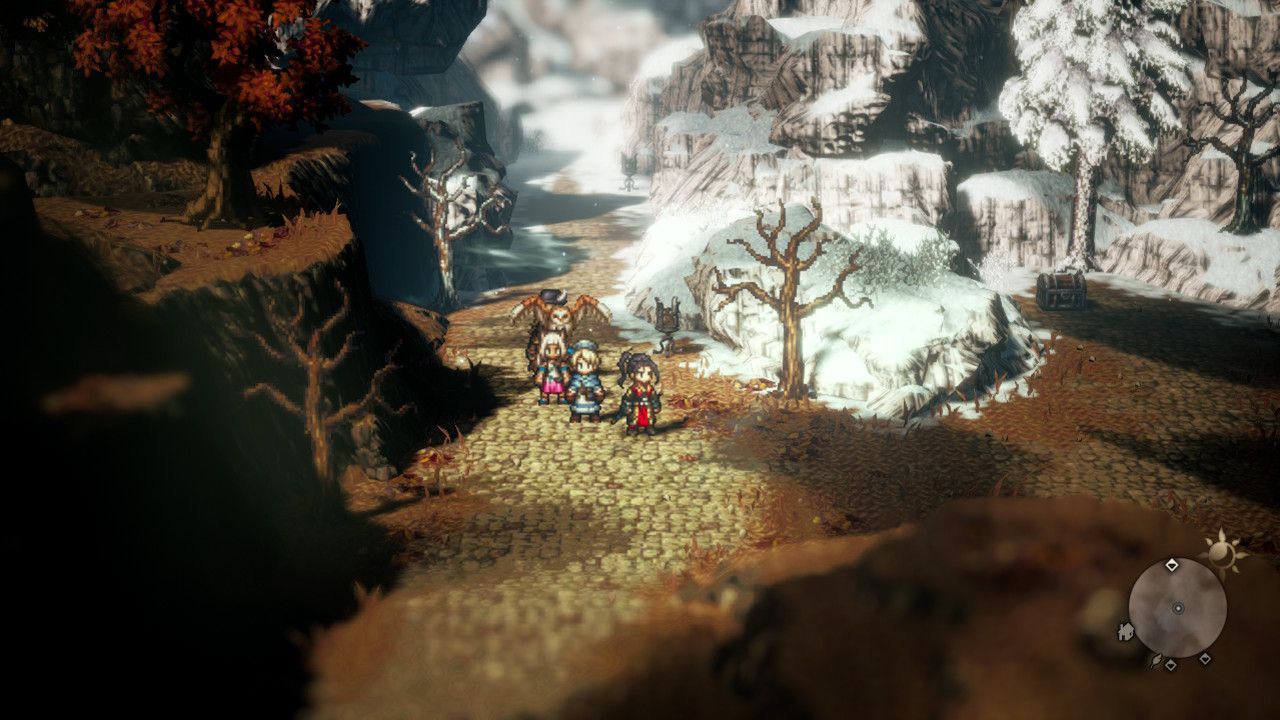
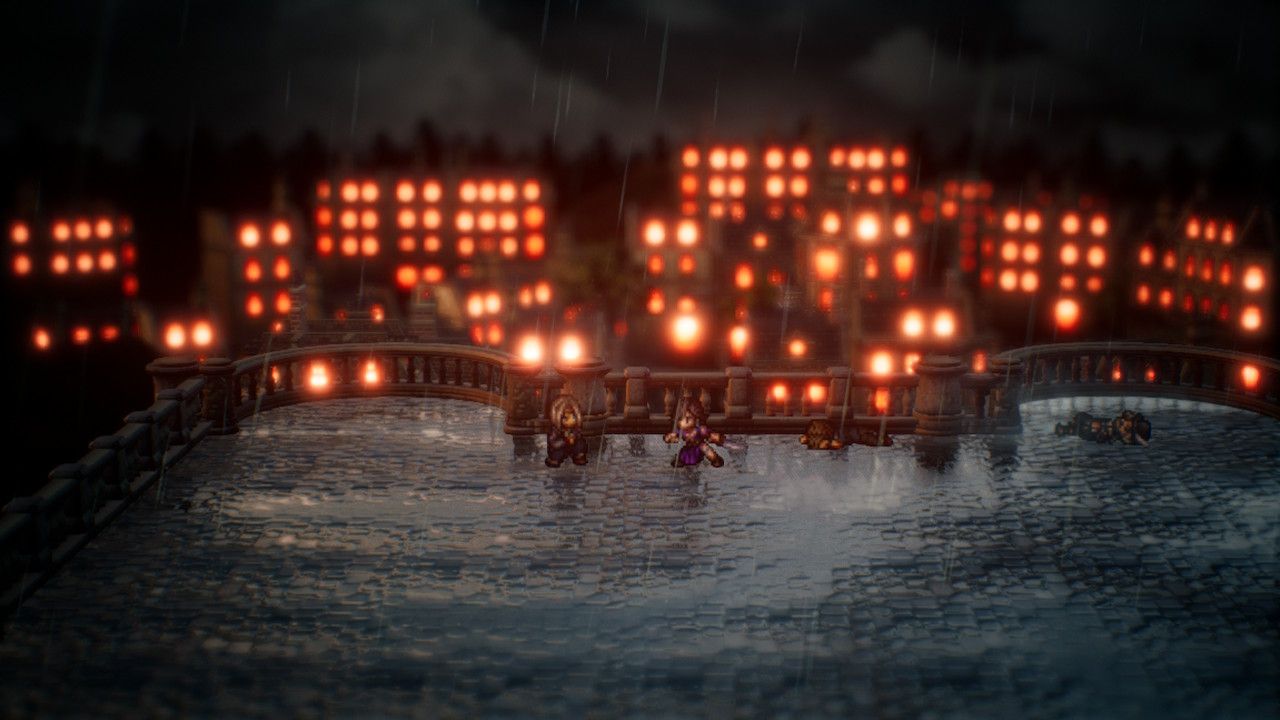
Octopath Traveler II. Source: Author.
Audiovisual Design From Different Perspectives
One of the most praised aspects of Octopath Traveler II is its art direction, featuring charming pixel art led by Mika Lizuka (and artwork by Naoki Ikushima). The game features several modern visual effects in Unreal Engine 4, as well as a camera perspective that gives scenery depth and an impression of the miniature. This technique, called "HD-2D", has been around since the first Octopath Traveler and is present in other games produced by Team Asano, but many critics considered that Octopath Traveler II is so far the apex of this design style.
"The stunning visuals that made the first Octopath Traveler such a standout are back, but are even more enhanced than before. Its blending of HD-2D graphics, retro pixel art, and 3DCG make Octopath Traveler II jaw-droppingly gorgeous. The lighting and particle effects are even more dramatic than before, as are the environments themselves. Even the character sprites have been reworked, giving them better proportions and cleaner animations."
— Heidi Hawes (WayTooManyGames)
"As a remake, for example, Live A Live worked with already existing material, while Triangle Strategy has limited scenarios. For its part, Octopath Traveler II is not only tasked with displaying a sprawling world with different biomes, but a day and night system is now included."
— Sebastian Quiroz (☆Atomix)
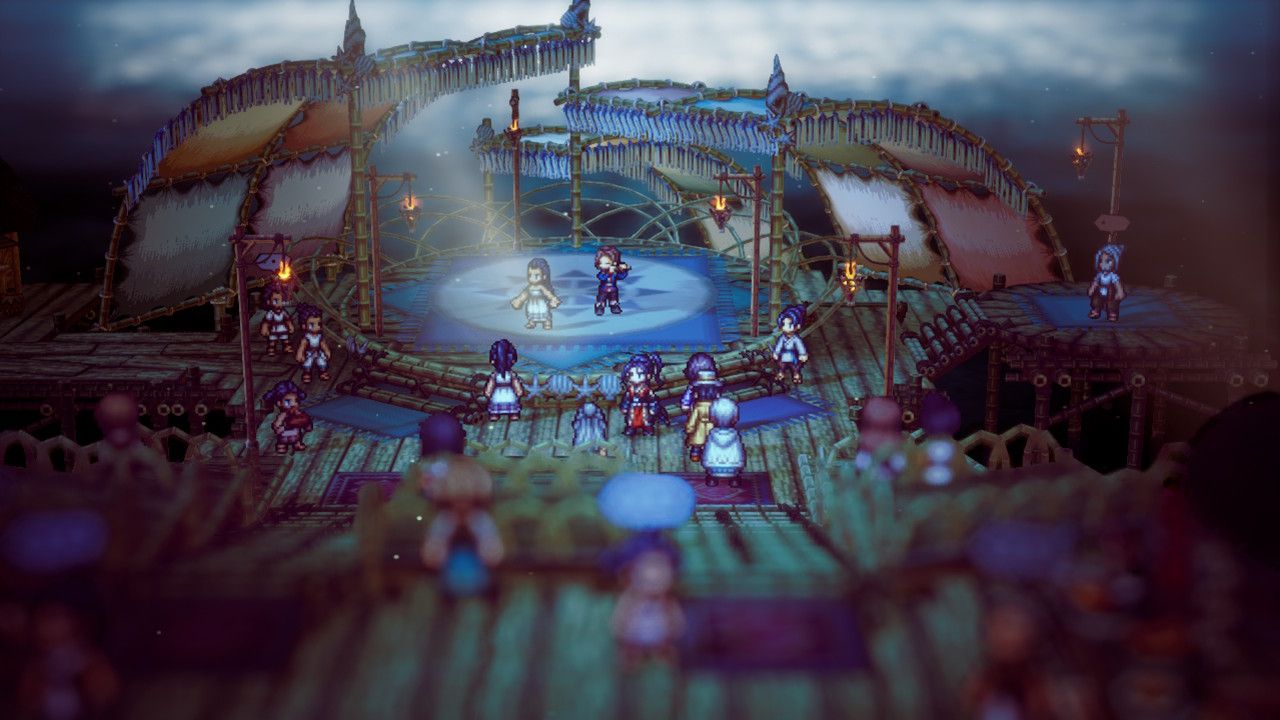
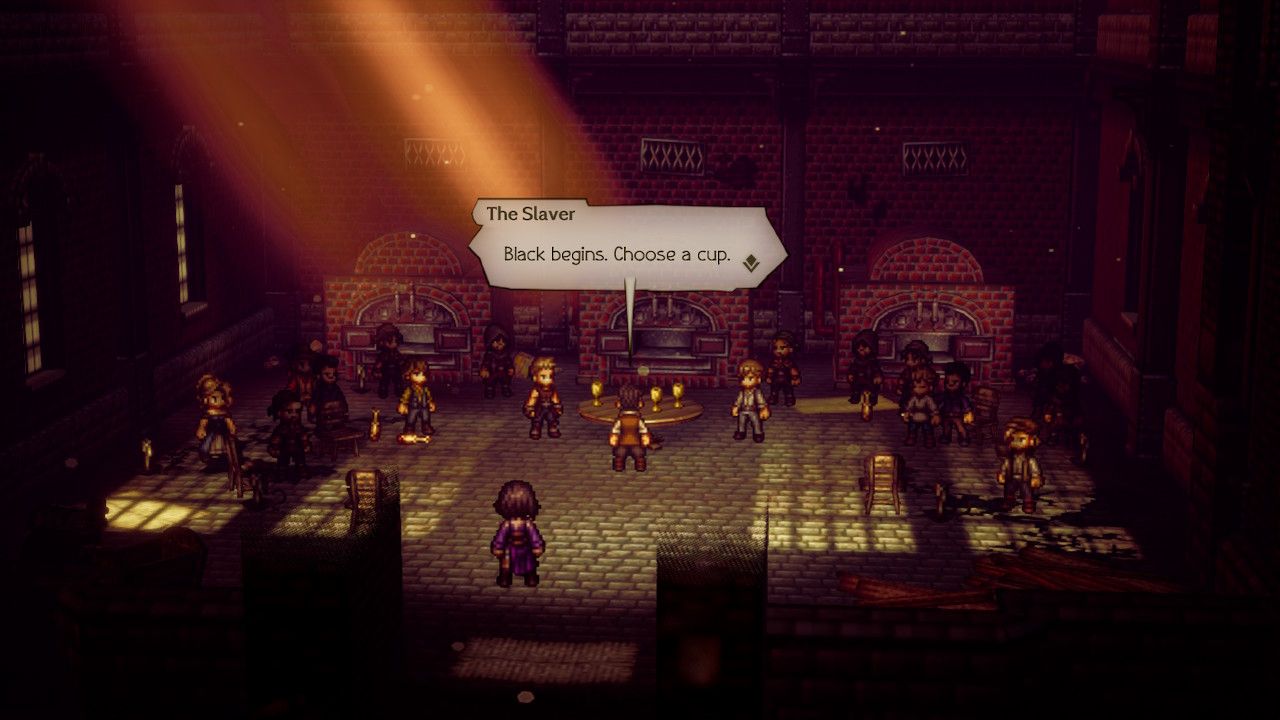
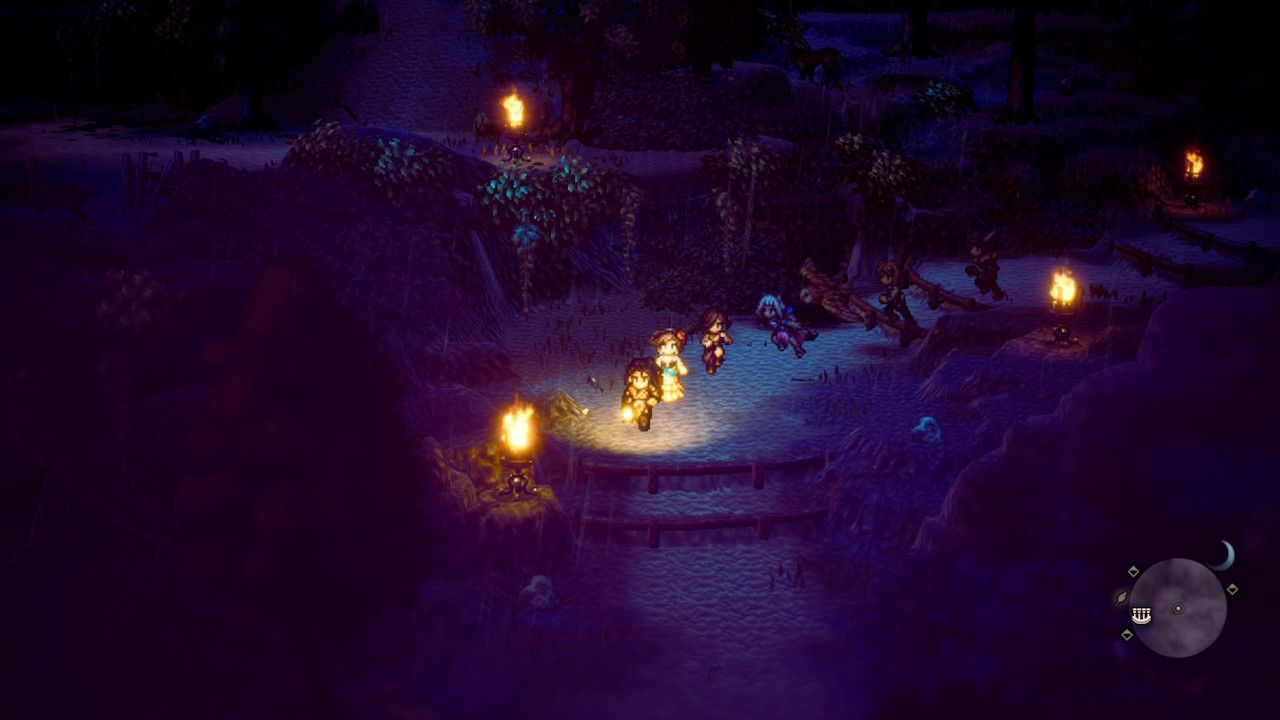
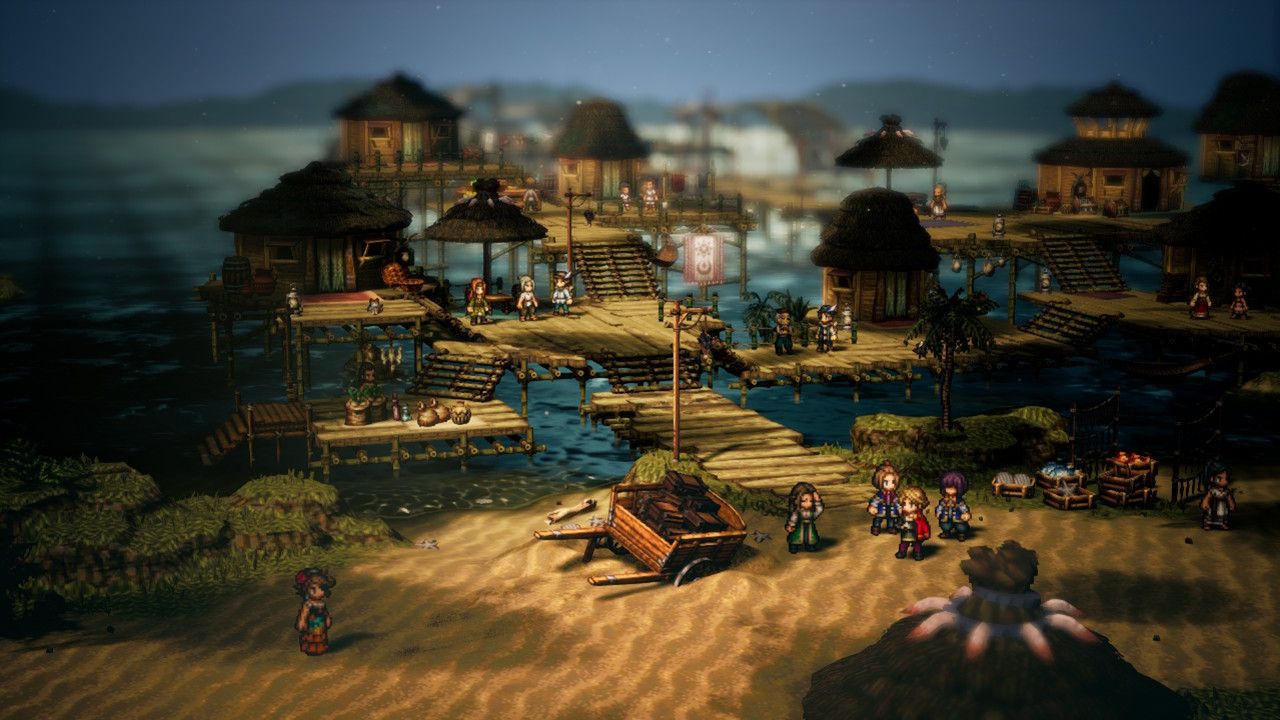
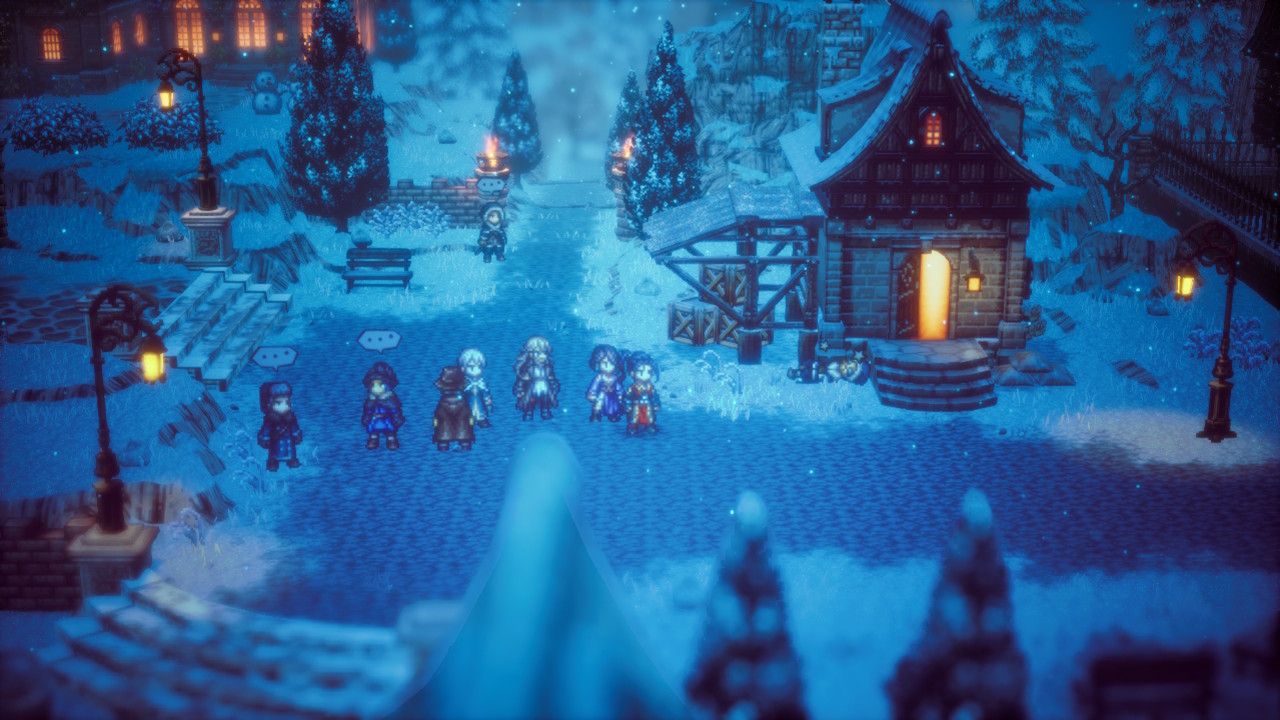
Octopath Traveler II. Source: Author.
However, there were some specific points where the HD-2D style of this series could still improve. It was noted, for example, that Triangle Strategy allowed camera rotation, something that is not present in Octopath Traveler, and Live A Live had less visual clutter in terms of visual effects. There is sometimes an excess of saturation, blur, lens flare, and other effects in Octopath Traveler II, even though critics acknowledge Team Asano has made this part of the style of the Octopath Traveler series.
"[...] the art direction [of Octopath Traveler II] keeps the cameras guided as in the previous game and in the remake of Live A Live (Switch), instead of having 3D scenarios with camera rotation, like those of Triangle Strategy. But don't worry, in several moments there are good camera angles, like in cinematics or when you apply some special abilities in combat. [...]
However, if [this game] approaches the HD2D of Live A Live in the camera, it moves away towards the light. While the remake of the Super Famicom classic was less exuberant in light effects, Octopath Traveler II follows the trends of its own series and fills your eyes with blur, lens flare and other lighting effects that often generate exaggerated contrasts or overshadow details and expressions of characters in some scenes."
— Vítor M. Costa (Nintendo Blast)
Yasunori Nishiki's compositions, once again, received high acclaim. While a few critics believed that the first Octopath Traveler had superior melodies, the majority acknowledged that the soundtrack for this game was just as impressive in overall terms. The score was particularly praised for its diverse range of timbres and harmonies.
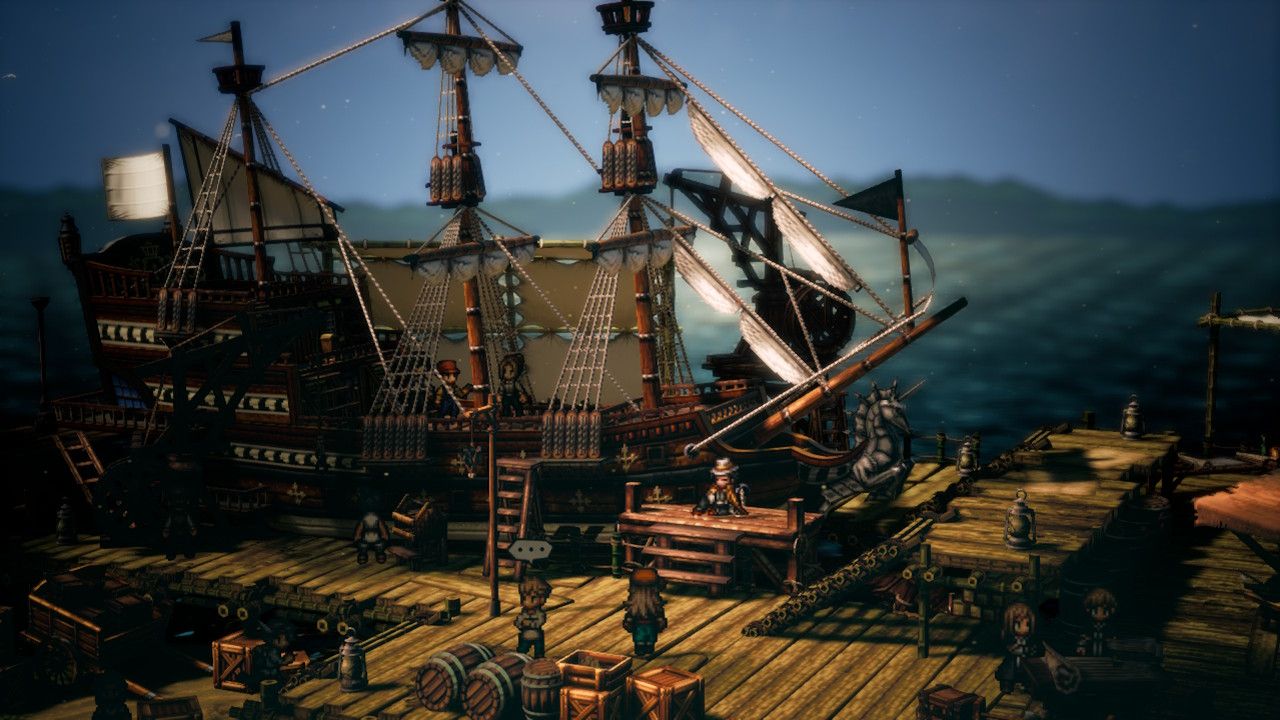
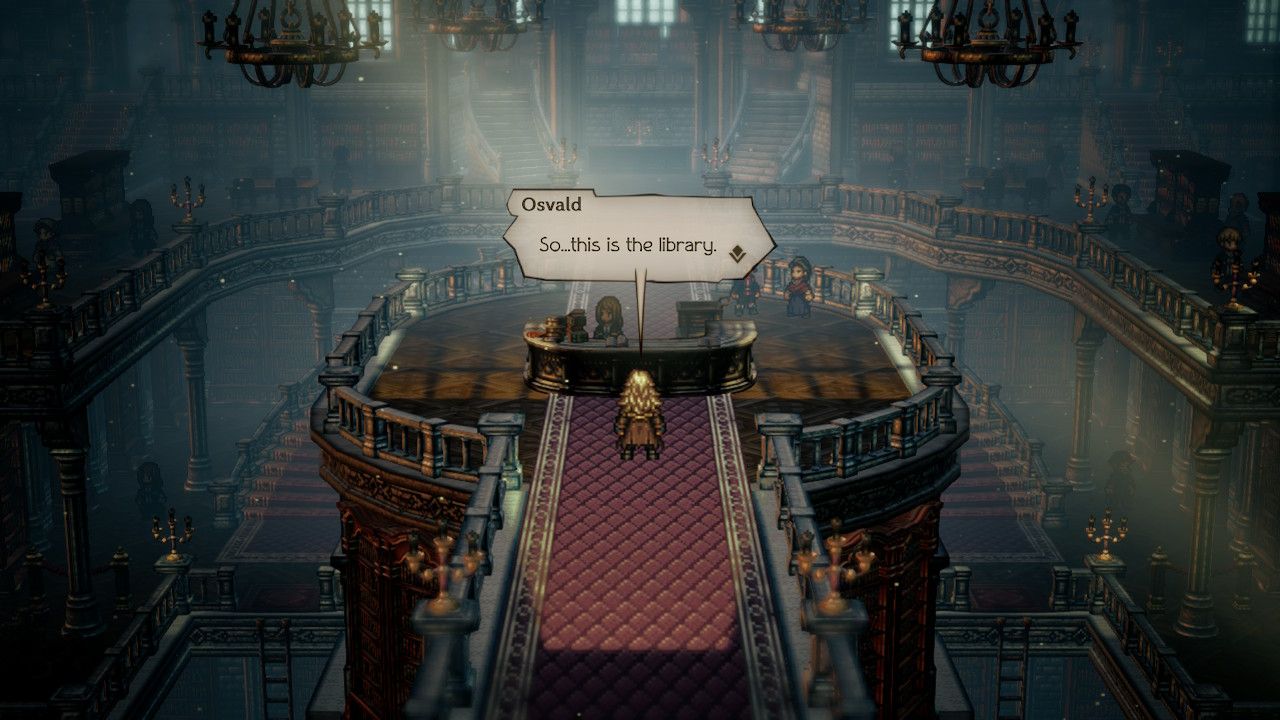
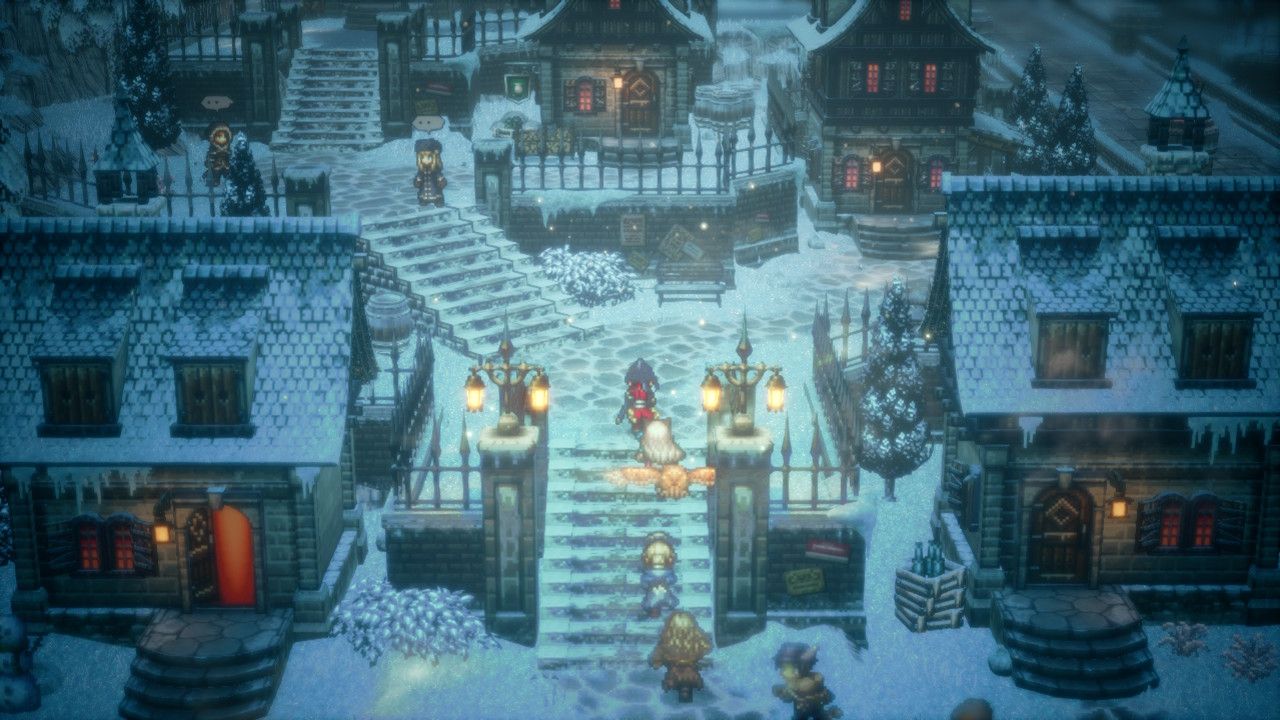
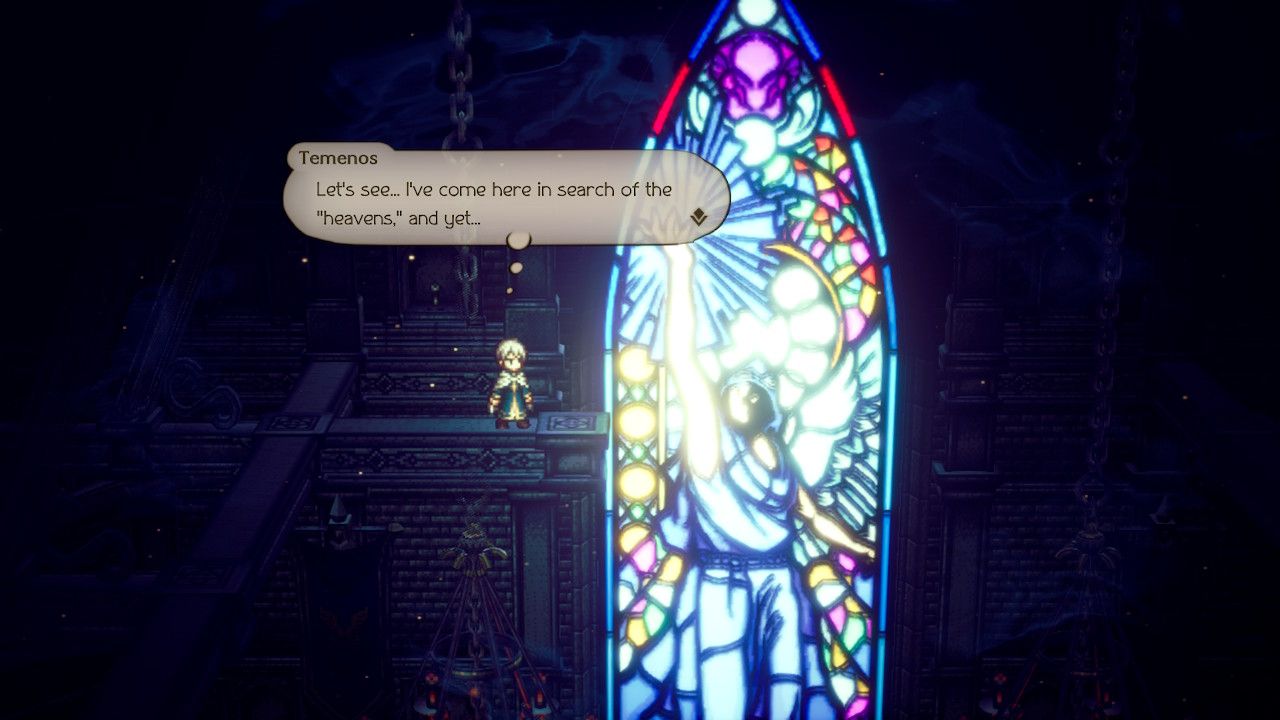
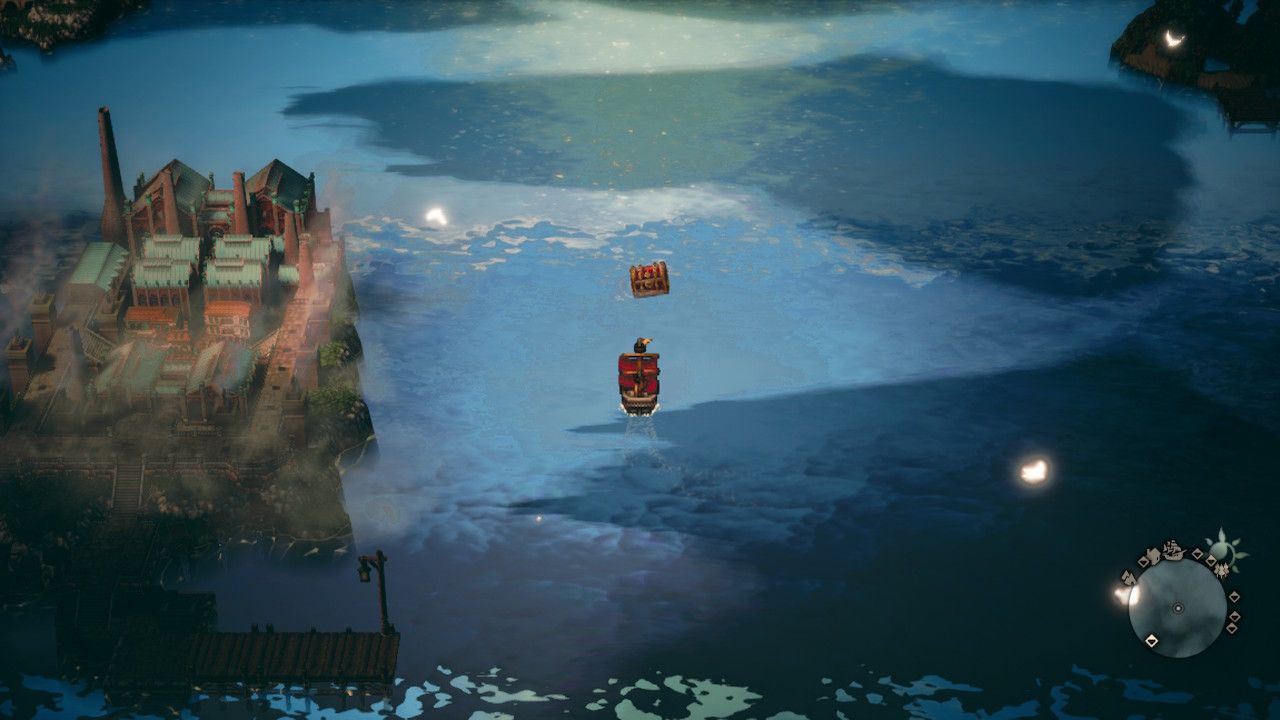

Octopath Traveler II. Source: Author.
"The music for Octopath Traveler II is probably Yasunori Nishiki's most impressive work to date. It uses everything that worked from the first title, and takes it to the next level by improving each of the possible sections. The eight themes work perfectly for each of the adventures. The compositions for the battles are capable of combining rock with the orchestra to provide the levels of emotion that are required at all times, while when exploring a town or pumpkin, something calmer can be appreciated that, eventually, gives rise to the more bizarre compositions than we are used to. A fantastic section from start to finish."
— Sebastian Quiroz (☆Atomix)
"His varied pieces often have melodies that emphasize strings (mostly) or woodwinds and are generally magically striking and cyclic without being irritating — like Decisive Battle 2 — and have some beautiful transitions, like in the final boss of the Agnea story. There are also relaxing and slightly danceable compositions in the cities - like jazz pieces in New Delsta - as well as some soft and beautiful songs in the voice of Yuria Miyazono."
— Vítor M. Costa (Nintendo Blast)
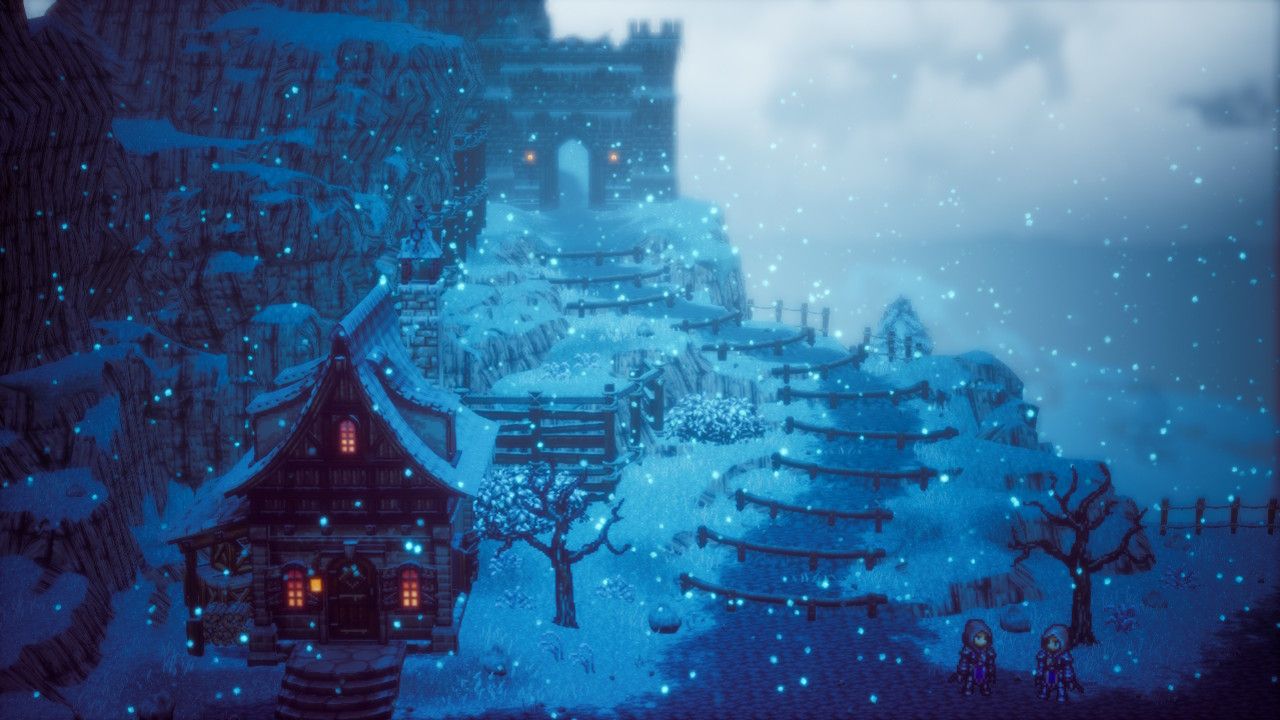
Consensus
Critics widely consider Octopath Traveler II as one of the best or perhaps the best game currently to implement the HD-2D technique, featuring an excellent soundtrack by Yasunori Nishiki, comparable to his award-winning work for Octopath Traveler (2018). Above all, the vast and varied world of this game stands out in a setting with a day-night cycle that can be explored by land and sea.
Despite its stunning audiovisual presentation, many critics believe that the gameplay is the standout feature of this game. Although the combat system remains comparable to the first Octopath Traveler, the sequel boasts several enhancements to the Job System and Latent Power mechanics, which significantly increase the game's dynamism, flexibility, and strategic depth. Utilizing the characters' individual skills on NPCs in cities also adds an extra layer of interest. However, it's worth noting that there are some downsides to this aspect, such as the necessity for grinding to advance the story. Nonetheless, there have been noticeable improvements compared to the previous game.
Finally, we have the narrative design of Octopath Traveler II that unanimously improved on its predecessor, but in some respects, it did not solve all the points criticized in the previous game. The eight characters with independent histories provide variety, but many of the plots are shallow, clichéd, and not always well-paced.
